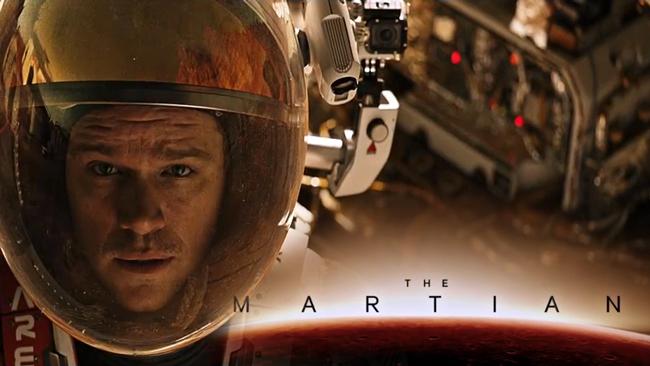
The Martian, is a film adaptation of the inventive, groundbreaking hard sci-fi adventure tale. Like Robinson Crusoe on Mars, it’s a triumph of engineering and basic science, a love letter to innovation and the greatest feats humans are capable of through collaboration. Directed by sci-fi legend Ridley Scott, and following in the footsteps of space epics Gravity and Interstellar, The Martian offers a stunning virtual imagination of Mars, glimpses of NASA’s new frontier – astronauts on Mars – and the stakes of a mission that will soon become a reality. Below, ScriptPhD.com reviews The Martian (an Editor’s Selection) and, with the help of a planetary researcher at The California Science Center, we break down some basics about Mars missions and the planetary science depicted in the film (interactive video).
That the film version of The Martian even exists is a testament to the unlikely success story of Andy Weir’s novel. A self-described science geek and gainfully employed computer programmer, he started writing a novel on the side, self-publishing chapter by chapter on an independent website. Word spread naturally, readers flocked, eventually, a completed book found a publisher and inevitably Hollywood came calling. Sounds about as realistic as… an astronaut being abandoned on a planet and having to make his own way back to Earth. But this is the exact fast-paced, thrilling plot behind one of the biggest hard sci-fi adventures of all time. Amidst an unexpected Martian sand storm, the crew of Ares 3 (the third fictionalized manned mission to Mars) becomes separated and erroneously thinks one of their members, Mark Watney, has died. They scramble to evacuate the red planet, leaving him very much alive with minimal food, water and tools to fend for himself and no communication to speak of.

With chemistry, botany, physics, engineering, home garage junk science and some self-deprecating humor, Watney must protect himself in the harsh Martian setting, figure out a way to let NASA know he’s alive, craft an escape plan, all while managing to overcome one after another devastating setback. At its heart, The Martian is a pure self-reliant survival tale, a staple of popular fiction. Despite its space setting and unapologetically elaborate scientific plot, it’s a story about a really smart guy who is – in the words of one of the many 70s disco songs throughout – stayin’ alive.
The movie adaptation remains mostly faithful to the central plot, necessarily trimming a few of Mark Watney’s perilous side adventures and unnecessarily supplanting Weir’s sardonic dialogue and one liners. The film sometimes lacks the ubiquitous sense of immediate urgency and desperation present throughout the book, but it makes up for it with more polished transitions and the ability to “think big” that is unique to cinema and critical to a science fiction. Most importantly, Matt Damon (as Watney) ably juggles vulnerability, scientific confidence and geek-chic sarcasm of an iconic sci-fi character.

One of the strengths of Weir’s book is the reader’s ability to visualize every detail of the Mars landscape and its phenomena through intricate first-person storytelling. The most important transition from such a detailed book to film is translating that visual realm, from the rolling red Martian plains and hills to the contrast of the confined space shuttle his crew is in to the chaotic flurry of NASA and the Jet Propulsion Laboratory. The vastness of the Martian terrain, incurring both abject loneliness and giddy awe in Watney (with whom we spend the majority of the film) is brilliantly rendered by Scott’s wide angles and grand, sweeping shots. It renders more power to a scene in which the astronaut, unsure if he’ll make it out alive, asks that his parents be told how happy he still is as a scientist, despite everything. “Tell them I love what I do. It’s important. It’s bigger than me.” In that moment, we truly believe him.
For a narrative in which the main character is forced to “science the s—t” out of his predicament, not knowing that back on Earth NASA is doing the very same, one would expect an endless supply of science and technology magic. In that regard, neither the book nor the movie disappoints. But what is truly surprising is the degree of plausibility and accuracy woven throughout the space survival tale. While all recent space films, including Gravity and Interstellar, have been meticulously well researched and inventive, The Martian compounds imagination with incredible scientific reality. For one thing, much of the technology already used by NASA is incorporated into the story. For another, author Andy Weir and director Ridley Scott reaffirmed how hard they worked to get the science right. “Originally The Martian was a serial that I had posted on my website chapter-by-chapter,” said author Weir. “If there were errors in the physics or chemistry problems or whatever, [my readers] would email me. It was great. I got sort of crowd-sourced fact checking. And while some of the science is still not quite air-tight, not only does The Martian take its science very seriously, it managed to thoroughly impress the toughest customer of all – NASA itself!
(For a full Mars primer and breakdown of the planetary science seen in the film, see ScriptPhD.com’s excusive video below.)
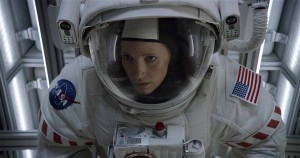
With all of the people furiously working to keep Watney alive – the NASA ground crew, Jet Propulsion Laboratory engineers, the Ares 3 crew, and even Watney himself – the real hero and main star of The Martian is science itself. Science facilitates Watney’s survival of the initial Martian storm, allows him to generate food and water to stay alive, traverse the unforgiving landscape and engineer a series of clever technological adaptations to establish communication and series of hopeful escape plans. Most importantly, it allows for an unlikely international alliance to save Watney. “It just goes to show,” [NASA Director] Teddy [Sander] said. “Love of science is universal across all cultures.” This important line from the book is reiterated in the film.
NASA has stated that it aspires to execute a manned mission to Mars by about 2030, a project no doubt buoyed by the exciting revelation that the Curiosity rover has found evidence of flowing water nearby. Expensive, dangerous missions, however, rely on public support for momentum – particularly because NASA research is publicly funded. And movies are often an important cultural gateway to engender and grow such support. NASA advisors of sci-fi film The Europa Report hoped it would inspire a real mission someday. One of ScriptPhD’s favorites from the last few years, Moon, and ambitious sci-fi hit Interstellar have the potential to re-ignite a new space race.
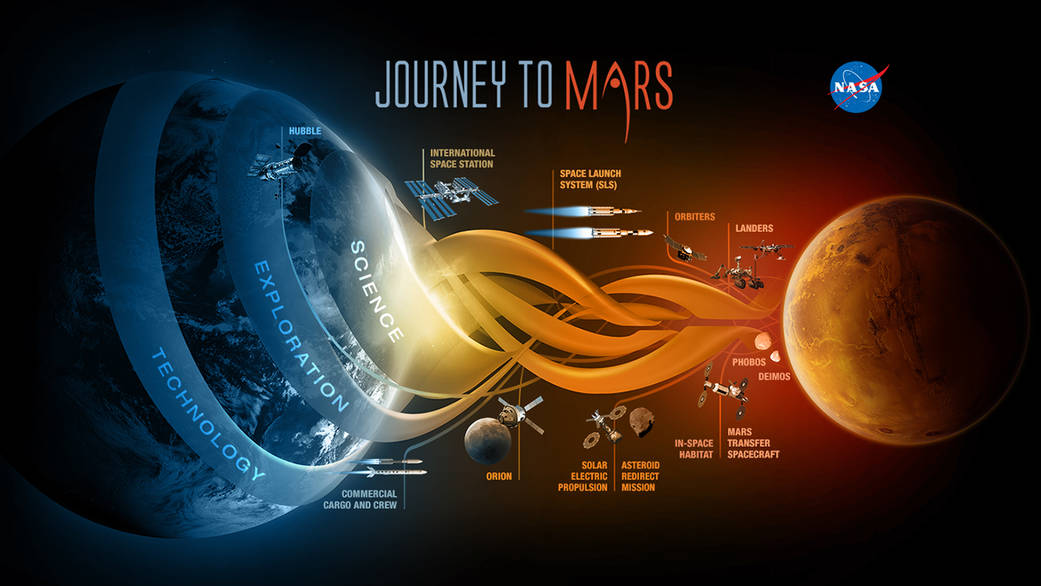
In an exclusive podcast with ScriptPhD.com a few years ago, noted astronomer and science communicator Brian Cox fervently advocated that NASA embrace its greatest challenge to date – manned exploration of Mars: because it’s hard, because we are meant to push the boundaries of the far edges of our galactic frontiers, because space exploration is the greatest universal manifestation of our ability to innovate and engineer. To the extent that The Martian manages to inspire and ignite this idea wih the mainstream public, it will stake claim as more than just a sci-fi benchmark. It will be seen as a catalyst for exploration history. After all, NASA did just announce plans to finally explore life on Jupiter’s moon Europa as depicted in Stanley Kubrik’s classic 2001: A Space Odyssey.
Interested in learning more about all the planetary science that goes into executing a Mars mission? The likelihood of Watney’s survival and some of the technical and scientific feats he pulls off on the red planet? I was privileged to head out to the California Science Center, location of the first ever Viking Mars rover prototype, to break down the science of Mars missions with Devin Waller, a planetary scientist and former Mars researcher.
*****************
ScriptPhD.com covers science and technology in entertainment, media and advertising. Hire our consulting company for creative content development. Follow us on Twitter and Facebook. Subscribe to our podcast on SoundCloud or iTunes.
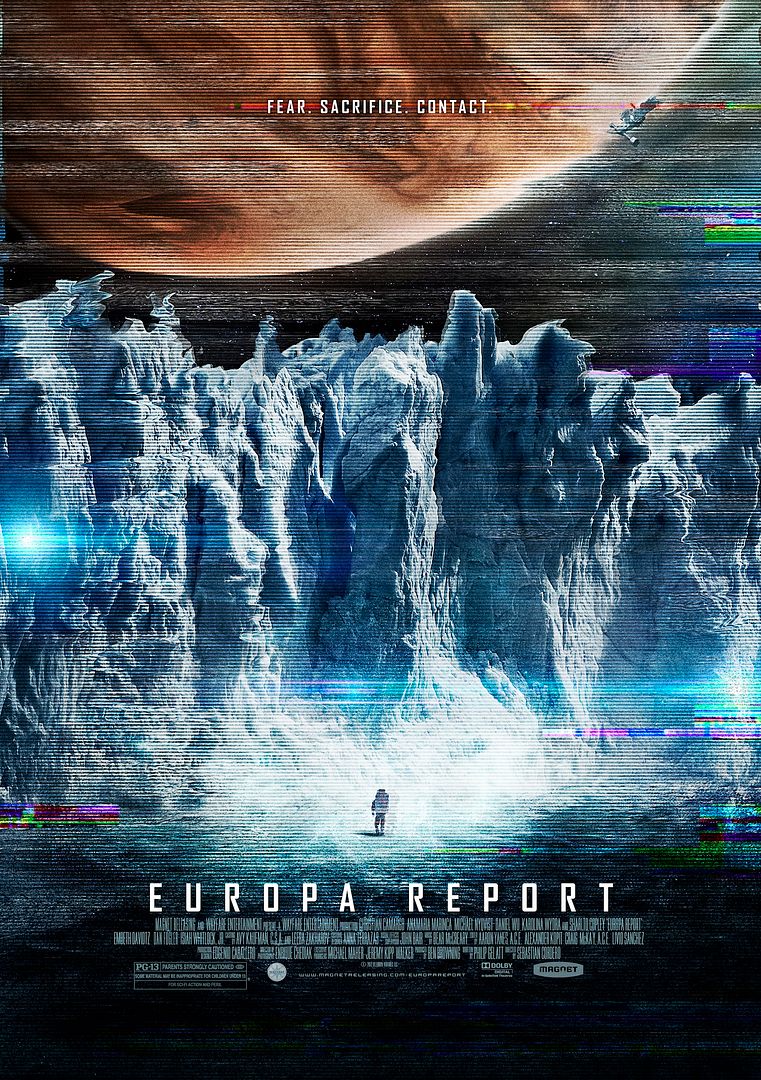
In 2007, new NASA research suggested that underneath the vast ice sheaths of Jupiter’s moon Europa lay oceanic water, which is a key element to support life. The Galileo probe, which had been orbiting the moons of Jupiter since December of 1995, was constantly orbiting and swooshing near the sixth largest moon in the solar system, collecting pictures and data that could prove the existence of liquid water. Then in 2011, scientists hit a proverbial jackpot—evidence for two liquid lakes the volume of the North American Great Lakes underneath a region of jumbled ice blocks termed the ‘Conamara Chaos.’ Even in the wake of such exciting discoveries, critical budget cuts severely threatened NASA’s space program, including the Mars rover and Cassini spacecraft orbiting Saturn. This same time frame gave concurrent rise to private space travel, led by the commercial venture Virgin Galactic and ambitious research company Space X. The merger of limitless industry resources with the possibility of uncovering alien life seems like a perfect Hollywood pitch. Such is the scenario explored in the brilliant documentary-style sci-fi thriller Europa Report. A full ScriptPhD review under the “continue reading” cut.
First conceptualized in 2009, prior to NASA’s landmark discovery of Jupiter’s large lakes, Europa Report explores the fundamental question driving space discovery: “Are we alone?” With private funds and advanced technology at their disposal, the fictitious Europa Ventures space exploration company enlists seven brilliant voyagers for the groundbreaking “Europa Mission,” the first venture beyond Earth’s orbit since 1972. Masterminded by company founders Drs. Samantha Unger and Tarik Pamuk, who also narrate the film and drive the story forward in current time, the multi-year investigative mission (16 months on Europa alone!) would combine state-of-the-art science with modern entertainment. Europa Report’s first act parlays the mundane lull of life in space—exercise to stave off atrophy, recycling urine for distilled water, ship engineers Andrei Blok and James Corrigan bickering in close quarters—overshadowed by the hints of future tragedy.
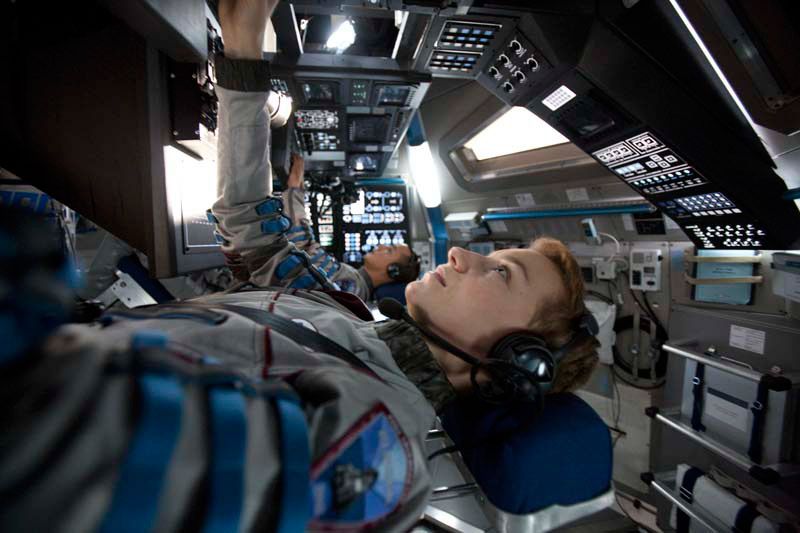
Indeed, approximately six months into their journey, the Europa Mission communications with ground control are cut off by an unexpected solar storm. From here, the film cleverly seesaws between the present and chronological flashbacks, as the crew bravely decides to press on with their journey. The film’s tempo subtlely, but effectively, picks up with a series of tragic events that affect the crew. When the ship is stranded on the moon’s surface due to heat beneath the ice surface, the crew take drastic steps, led by pilot Rosa Dasque to ensure that the precious data they collected is not for naught.
Europa Report is easily the most realistic depiction of travel and life in space since 2009’s Moon and the 1960s standard-bearer 2001: A Space Odyssey. Committed to the accuracy of its sets, shuttle, space imagery and scientific data, Europa Report relied on heavy consultation with NASA/Jet Propulsion Laboratory, SpaceX and other scientific leaders from the planning and execution of the mission to what the surface of Europa would look like. Filmmakers worked with astrobiologists to conceive theoretical, yet plausible, Europa life forms from the bioluminescent ones that exist deep in the Earth’s oceans. The depiction of the Europa landing is one of the most exciting science movie moments I have ever seen on screen.

With the help of NASA and SpaceX, set designer Eugenio Caballero built a fully authentic spaceship, including living quarters, control area and zero gravity wirework. After production was complete, the visual effects team replicated the Europa exterior environment based on data and imagery collected during the Galileo mission. Perhaps as a result, some of the film’s strongest sequences occur when Dr. Katya Petrovna tenuously ventures on the icy surface to collect data and explore the surroundings, leading to the heart-stopping conclusion that both seals the team’s ultimate fate and reaffirms the value of their mission.
“This project felt like a unique opportunity to do something plausible but forward thinking, somewhere between NASA and Star Trek,” said Ben Browning, whose company Wayfare Entertainment developed the film.
Europa Report is constructed to feel like a documentary or voyeuristic web stream of a very real (and altogether possible) scientific experiment. That a reality show would be borne of such an undertaking is a foregone conclusion. Nevertheless, the film leaves several important overarching existential questions that we must examine in our inevitable quest to search the galaxy for extra-terrestrial life. Even if we find life forms in the outer galaxy, do we really want to know what’s out there? Or perturb it? In the case of Europa Report, a terrifying conclusion conjures up as many fears as it answers exciting possibilities. Secondly, as technology makes extreme space travel to previously-unreached distances possible, we must never forget the element of danger that fuels the bravery of the astronauts and scientist that
undertake these endeavors. Lastly, is the commercialization of space a good idea? In the wake of celebrities buying shuttle rides into Earth’s orbit and space ventures funded by billionaires, who will maintain regulatory oversight and scientific integrity?
Ultimately, it’s inevitable that there will be a real-life mission to Europa, or even beyond. And an even bigger possibility that a groundbreaking discovery of current life in outer space will be made. But until that day, Europa Report unveils a grand science experiment before our eyes and perhaps, even a glimpse into the future.
View a trailer for Europa Report:
Europa Report goes into limited theatrical release on August 2, 2013 and is available On Demand.
~*ScriptPhD*~
*****************
ScriptPhD.com covers science and technology in entertainment, media and advertising. Hire our consulting company for creative content development.
Subscribe to free email notifications of new posts on our home page.
]]>
The history of science movies nominated for Oscars is not a very long one. Aside from the technical achievement awards or an occasional nomination for acting merits, the Best Picture category has historically not opened its doors to scientific content, save for notable nominees “A Clockwork Orange,” “District 9,” “Inception” and “Avatar.” A documentary about science has never been nominated for the Best Documentary category, until this year, with How To Survive a Plague, Director David France’s stunning account of the brave activists that brought the AIDS epidemic to the attention of the government and science community in the disease’s darkest early days. “Plague” set history last weekend by becoming the first “Best Documentary” nominee with an almost entirely scientific/biomedical narrative. More importantly, it also established a standard by which future science documentaries should use emotional storytelling to captivate audiences and inspire action. ScriptPhD review and discussion under the “continue reading” cut.
“How To Survive a Plague” picks up where groundbreaking companion AIDS film “And the Band Played On” drops off, around 1987, with the formation of the AIDS Coalition to Unleash Power (ACT UP) advocacy group, which is the central protagonist of the documentary. The AIDS virus had been identified, isolated and diagnosed in patients. But as a running ticker throughout the movie reminds us, the AIDS death toll knew no limit. By 1988, 70,000 people had already perished, a number that would climb to an astonishing 500,000 by 1997. Complacency and frustration were the norm among medical professionals, who treated patients with a series of “what the hell” drugs, when they’d even consider treating them. The scientific community, although recognizing that research was necessary, devoted little money or manpower. Even early drugs that showed experimental efficacy or relieved symptoms in AIDS patients were dismissed.
Scientists and the government were the targets of ACT UP’s fury and protests.
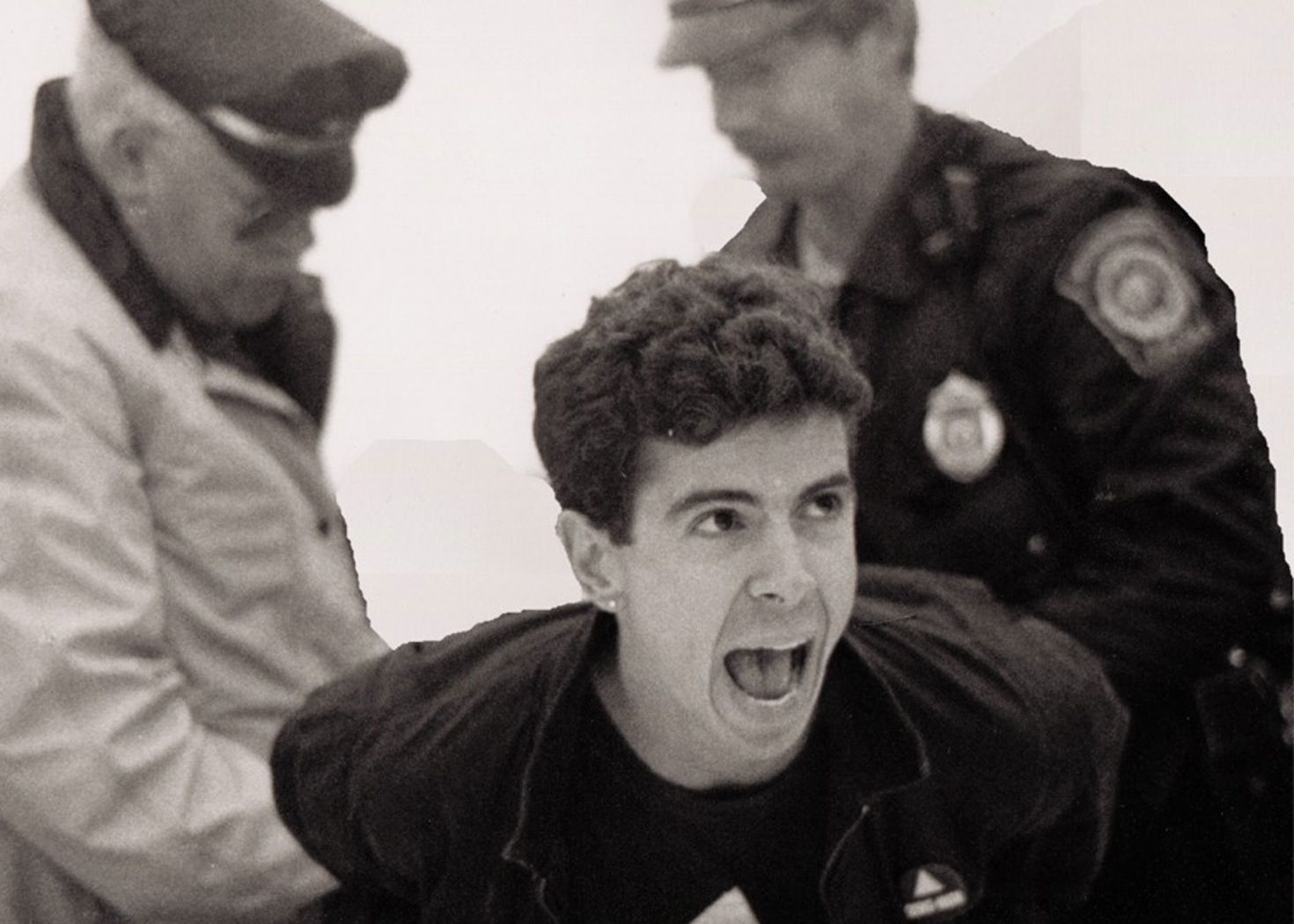
But by the late 80s/early 90s, ACT UP’s mission had reached a critical Phase II: conformity. Extremists and truculent zealots were dismissed to the sidelines, while the group became self-made scientists, learning everything from medicine to virology and immunology to chemistry. Rather than shut down the FDA for a day like they’d done years ago, they showed up to a scientific meeting in suits and ties to hand out a well-thought-out publication worthy proposal on AIDS research and treatment timelines. Impressed scientists took note. By the time charming ACT UP leader Peter Staley addresses an international convention meeting of the American Society for Microbiology, he is given a standing ovation. ACT UP’s fight, the fight of the gay community, had now become a global fight.
In many ways, “How To Survive a Plague” is an emotional contrast to “And the Band Played On,” even though the former is a documentary largely consisting of reel footage of the events it portrays, while the latter is a dramatized account of scientists racing to find the identity of the AIDS virus. Although “Band” touches briefly on the fear, government insouciance and distrust within the gay community in the earliest days of the bourgeoning epidemic, it is very much a pure science film. Its themes of persistence, no-holds-barred competition, stunningly accurate epidemiology and virology details and race to an answer could be about any virus in any historical time. “Plague” puts all of the science and medicine of the AIDS crisis in an emotional and historical context. A running death ticker as the years pass lends an urgency to the battle of the ACT UP activists. Moreover, France inserts actual footage of their protests (the most famous being an all-day takeover of the National Institutes of Health), meetings and press conferences, and difficult-to-watch footage of AIDS that shines an intimate spotlight of realism on the crisis. As France notes, the AIDS crisis burgeoned concomitantly with the appearance of the camcorder, making early AIDS activists “the very first social movement to shoot a world the dominant culture was ignoring.”

Scientists in the movie range from heroes and anti-heroes to ordinary people, which is a rarity in entertainment media. By far the biggest hero is Dr. Iris Long, a chemist with 20 years of experience in retroviral drug development. Although she knew no one with AIDS and never met a homosexual in her life, Dr. Long became a mentor and science advisor to ACT UP. Her fearless leadership and ability to educate the members led to direct reforms at the FDA and NIH. Other members like Bill Bahlman (the first to demand a direct drug treatment for AIDS) and Garance Franke-Ruta (a high school drop out and science nerd who became the group’s leading advocate for science-based activism) led the internal change to join forces with scientists rather than fighting them. And for every scientist that ignored the AIDS crisis was a research pioneer like Anthony Faucci, now head of the NIH Institute of Allergy and Infectious Disease, or a Merck chemist leading the development of anti-retroviral drugs. Moments after a graphics-filled technical explanation of how anti-retroviral drugs inhibit HIV virus replication, one of the Merck scientists interviewed in the film broke down into tears when recollecting the enormity of what they’d accomplished. It’s a stunning, raw moment in a film filled with them. Recent advances in writing for sci-fi have painted more complex, human depictions of scientists and researchers. But such insights are far too rare in documentaries.
In a strangely macabre way, “Plague” is an emotional feel good story, but one that isn’t over yet. Through the darkest days of rallying a tone-deaf world, all the while losing members day by day, ACT UP’s commitment and perseverance never failed. By the time surviving members, some of whom professed in footage that they never expected to live, are finally revealed in the present day in the film’s last act, the audience is flooded with gratitude and catharsis. The science world, which once didn’t know what to make of this emerging virus, took only one year from the time the first protease inhibitor hit the market to come up with and approve the current three-drug treatment cocktail.
But the film’s unstated, looming conclusion is that we will never get back the millions of people who died during a decade of silence. Too many people continue to perish, most in what has become a new frontier for the AIDS crisis. The fight for a cure or prevention is not over. And a new plague could always be around the corner. It is our hope that future documentarians take note of both the film’s message and its delivery style.
Take a look at the official trailer for “How To Survive a Plague”:
~*ScriptPhD*~
*****************
ScriptPhD.com covers science and technology in entertainment, media and advertising. Hire our consulting company for creative content development.
Subscribe to free email notifications of new posts on our home page.
]]>
For every friendly robot we see in science fiction such as Star Wars‘s C3PO, there are others with a more sinister reputation that you can find in films such as I, Robot. Indeed, most movie robots can be classified into a range of archetypes and purposes. Science boffins at Cambridge University have taken the unusual step of evaluating the exact risks of humanity suffering from a Terminator-style meltdown at the Cambridge Project for Existential Risk.
“Robots On the Run” is currently an unlikely scenario, so don’t stockpile rations and weapons in panic just yet. But with machine intelligence continually evolving, developing and even crossing thresholds of creativity and and language, what holds now might not in the future. Robotic technology is making huge advances in great part thanks to the efforts of Japanese scientists and Robot Wars. For the time being, the term AI (artificial intelligence) might sound like a Hollywood invention (the term was translated by Steven Spielberg in a landmark film, after all), but the science behind it is real and proliferating in terms of capability and application. Robots can now “learn” things through circuitry similar to the way humans pick up information. Nevertheless, some scientists believe that there are limits to the level of intelligence that robots will be able to achieve in the future. In a special ScriptPhD review, we examine the current state of artificial intelligence, and the possibilities that the future holds for this technology.
Is AI a false dawn?
While artificial intelligence has certainly delivered impressive advances in some respects, it has also not successfully implemented the kind of groundbreaking high-order human activity that some would have envisaged long ago. Replicating technology such as thought, conversation and reasoning in robots is extraordinarily complicated. Take, for example, teaching robots to talk. AI programming has enabled robots to hold rudimentary conversations together, but the conversation observed here is extremely simple and far from matching or surpassing even everyday human chit-chat. There have been other advances in AI, but these tend to be fairly singular in approach. In essence, it is possible to get AI machines to perform some of the tasks we humans can cope with, as witnessed by the robot “Watson” defeating humanity’s best and brightest at the quiz show Jeopardy!, but we are very far away from creating a complete robot that can manage humanity’s complex levels of multi-tasking.
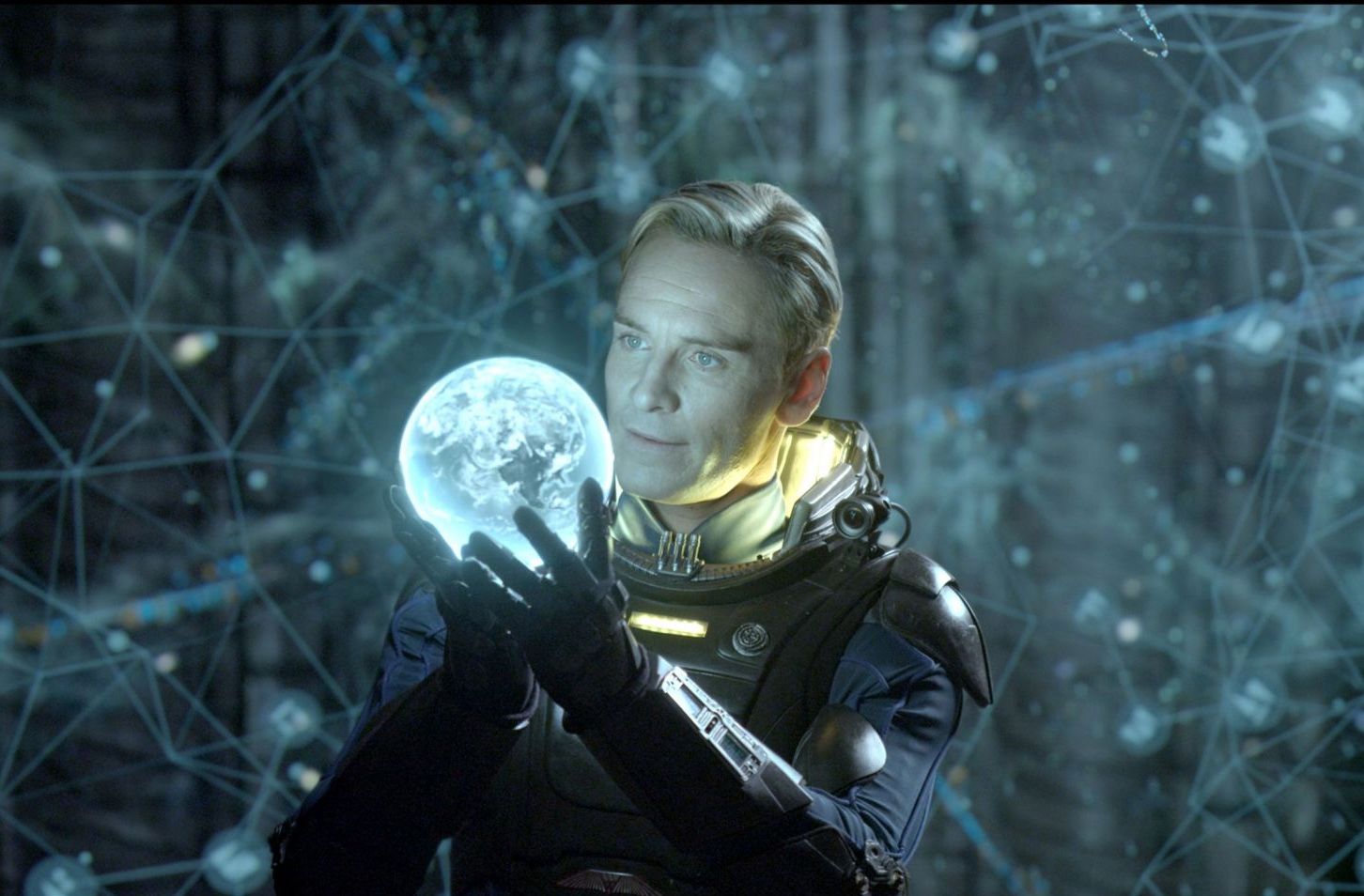
Despite these modest advances to date, technology throughout history has often evolved in a hyperbolic pattern after a long, linear period of discovery and research. For example, as the Cambridge scientists pointed out, many people doubted the possibility of heavier-than-air flight. This has been achieved and improved many times over, even to supersonic speeds, since the Wright Brothers’ unprecedented world’s first successful airplane flight. In last year’s sci-fi epic Prometheus the android David is an engineered human designed to assist an exploratory ship’s crew in every way. David anticipates their desires, needs, yet also exhibits the ability to reason, share emotions and feel complex meta-awareness. Forward-reaching? Not possible now? Perhaps. But by 2050, computers controlling robot “brains” will be able to execute 100 trillion instructions per second, on par with human brain activity. How those robots order and utilize these trillions of thoughts, only time will tell!
If nature can engineer it, why can’t we?
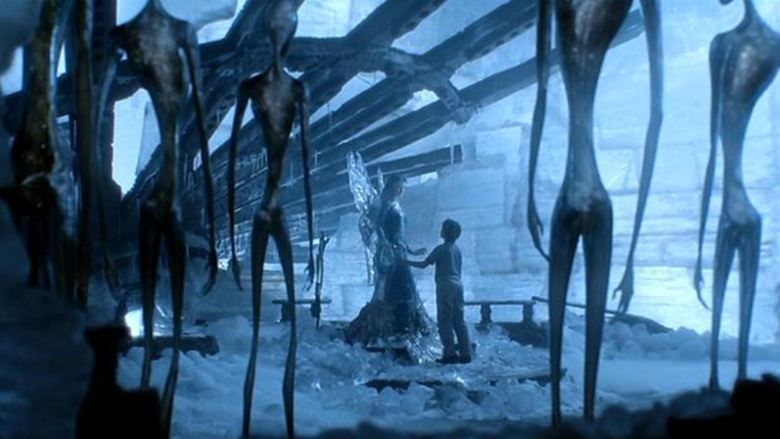
The human brain is a marvelous feat of natural engineering. Making sense of this unique organ singularly differentiates the human species from all others requires a conglomeration of neuroscience, mathematics and physiology. MIT neuroscientist Sebastian Seung is attempting to do precisely that – reverse engineer the human brain in order to map out every neuron and connection therein, creating a road map to how we think and function. The feat, called the connectome, is likely to be accomplished by 2020, and is probably the first tentative step towards creating a machine that is more powerful than human brain. No supercomputer that can simulate the human brain exists yet. But researchers at the IBM cognitive computing project, backed by a $5 million grant from US military research arm DARPA, aim to engineer software simulations that will complement hardware chips modeled after how the human brain works. The research is already being implemented by DARPA into brain implants that have better control of artificial prosthetic limbs.
The plausibility that technology will catch up to millions of years of evolution in a few years’ time seems inevitable. But the question remains… what then? In a brilliant recent New York Times editorial, University of Cambridge philosopher Huw Price muses about the nature of human existentialism in an age of the singularity. “Indeed, it’s not really clear who “we” would be, in those circumstances. Would we be humans surviving (or not) in an environment in which superior machine intelligences had taken the reins, to speak? Would we be human intelligences somehow extended by nonbiological means? Would we be in some sense entirely posthuman (though thinking of ourselves perhaps as descendants of humans)?” Amidst the fears of what engineered beings, robotic or otherwise, would do to us, lies an even scarier question, most recently explored in Vincenzo Natali’s sci-fi horror epic Splice: what responsibility do we hold for what we did to them?
Is it already checkmate, AI?

Artificial intelligence computers have already beaten humans hands down in a number of computational metrics, perhaps most notably when the IBM chess computer Deep Blue outwitted then-world champion Gary Kasparov back in 1997, or the more recent aforementioned quiz show trouncing by deep learning QA machine Watson. There are many reasons behind these supercomputing landmarks, not the least of which is a much quicker capacity for calculations, along with not being subject to the vagaries of human error. Thus, from the narrow AI point of view, hyper-programmed robots are already well on their way, buoyed by hardware and computing advances and programming capacity. According to Moore’s law, the amount of computing power we can fit on a chip doubles every two years, an accurate estimation to date, despite skeptics who claim that the dynamics of Moore’s law will eventually reach a limit. Nevertheless, futurist Ray Kurtzweil predicts that computers’ role in our lives will expand far beyond tablets, phones and the Internet. Taking a page out of The Terminator, Kurtzweil believes that humans will eventually be implanted with computers (a sort of artificial intelligence chimera) for longer life and more extensive brain capacity. If the researchers developing artificial intelligence at Google X Labs have their say, this feat will arrive sooner rather than later.
There may be no I in robot, but that does not necessarily mean that advanced artificial beings would be altruistic, or even remotely friendly to their organic human counterparts. They do not (yet) have the emotions, free will and values that humans use to guide our decision-making. While it is unlikely that robots would necessarily be outright hostile to humans, it is possible that they would be indifferent to us, or even worse, think that we are a danger to ourselves and the planet and seek to either restrict our freedom or do away with humans entirely. At the very least, development and use of this technology will yield considerable novel ethical and moral quandaries.
It may be difficult to predict what the future of technology holds just yet, but in the meantime, humanity can be comforted by the knowledge that it will be a while before robots, or artificial intelligence of any kind, subsumes our existence.
*****************
ScriptPhD.com covers science and technology in entertainment, media and advertising. Hire our consulting company for creative content development. Follow us on Twitter and Facebook. Subscribe to our podcast on SoundCloud or iTunes.
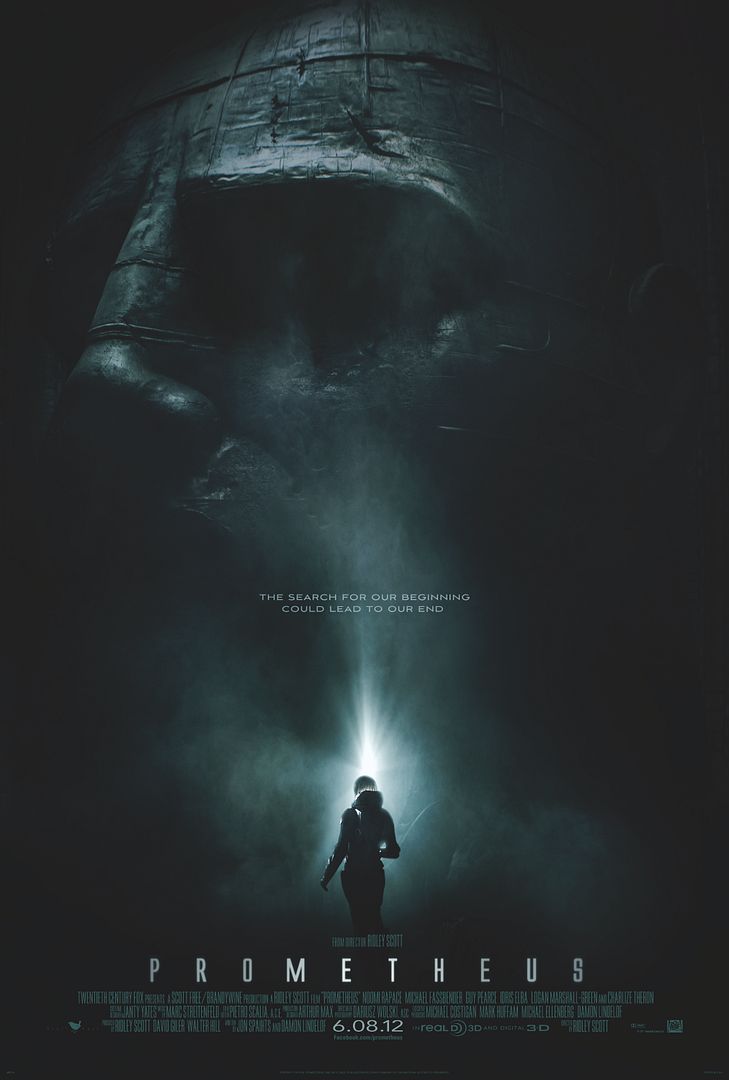
It has been three decades since Ridley Scott’s acclaimed sci-fi masterpiece Blade Runner practically reinvented the genre, and he has not made another sci-fi film since. “The reason I haven’t made another sci-fi film in so may years,” he says “is because I haven’t come across anything worthwhile for me to do with enough truth, originality and strength. Prometheus has all three.” With such heightened expectations, one would expect a bold, daring, all-encompassing storyline from Scott. Loosely based on elements from Alien, and originally intended as a prequel to that film, Prometheus meets many of those expectations, especially in visual and action content, while falling short on others. Full ScriptPhD review, under the “continue reading” cut.
Set 80 years in the future, a team of archaeologists discovers a series of cave etchings with a clue to the origins of mankind on Earth—a far-away planet in the darkest corners of the Universe. Commissioned by the corporate conglomerate Weyland Corporation, the $1 trillion scientific exploratory journey is originally intended to meet our makers in their native land. But when the team makes the shocking discovery that their makers’ paradise is a way station for a dangerous experiment in bioengineering, they begin the fight of their life to save humanity.
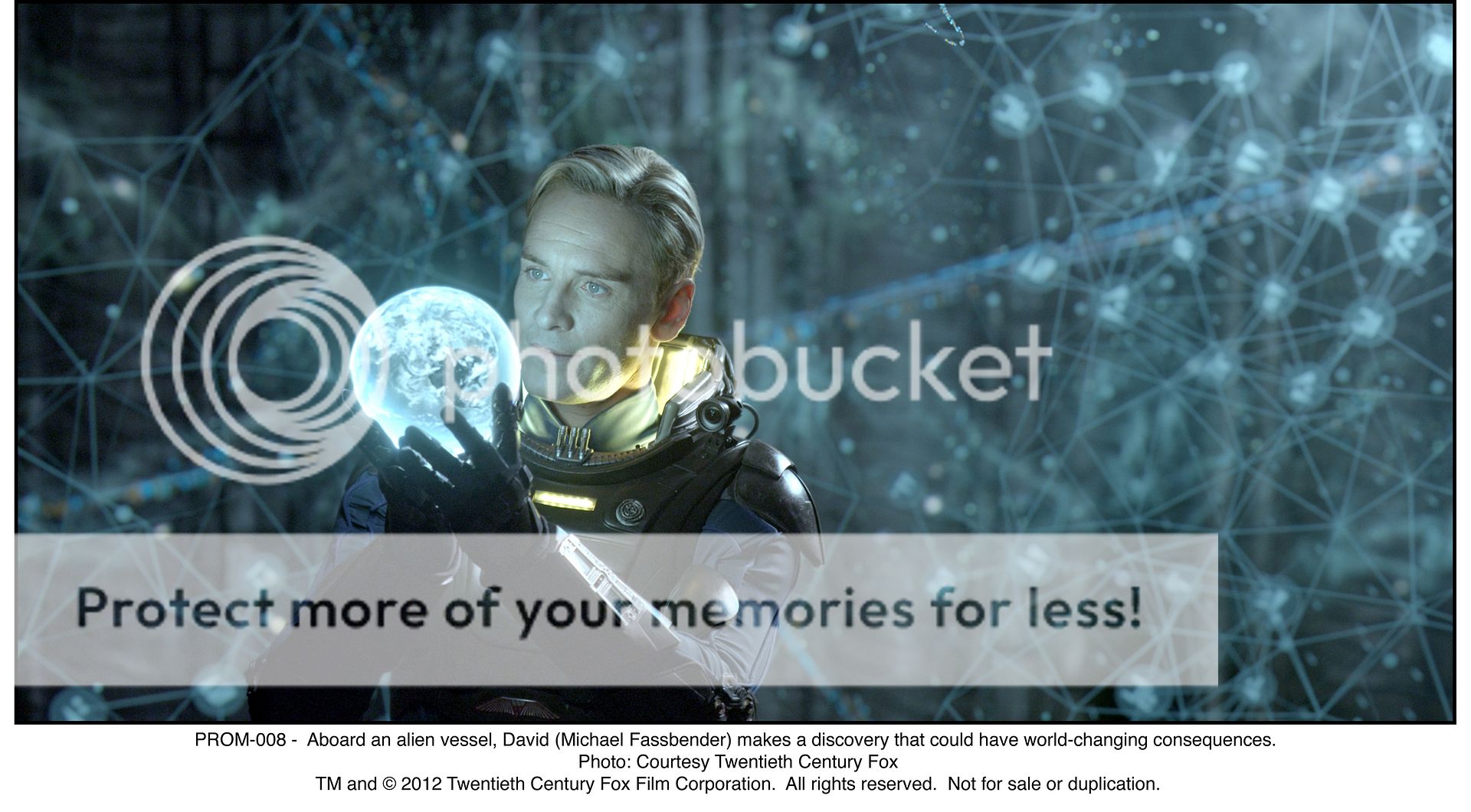
Interspersed within this non-stop intergalactic thrill ride are a series of conflicts between the crew members that challenge some of our most cherished scientific and philosophical ideas, conflicts we may ourselves be forced to address in the near future. The sterile, corporate (and somewhat surprisingly selfish) interests of the journey, funded by enigmatic Peter Weyland and carried out by Weyland Industries executive Meredith Vickers are in stark contrast to the spirit of scientific exploration for the sake of discovery and learning. The mission’s lead scientists are archetypes for the conflict of faith versus science. Elizabeth Shaw is deeply religious, and views the mission as a chance to meet the Gods, to affirm her faith and everything she believes in. Her partner, both in the lab and personally, Charlie Holloway is a classic adventurous scientist who is on the journey to push the envelope in the quest for answers. Finally, rounding out
the crew of 17 scientists is David, a human-replica android servant of superior intelligence created by the Weyland Corporation. David is an amalgamation of virtually every artificial intelligence character sci-fi has ever created, from Hal to C-3PO to the Terminator. Originally manufactured to tend to the ship during the two-year journey and to gather intelligence, David is nevertheless acutely aware of his superiority over his human charges. He even has the will to help them figure out the nefarious scheme of the alien predecessors and fight a battle for their survival. Responding to Holloway’s flippant response that humans made David simply because they could, he retorts: “Imagine how disappointed you’d be if your makers gave you the same response?”
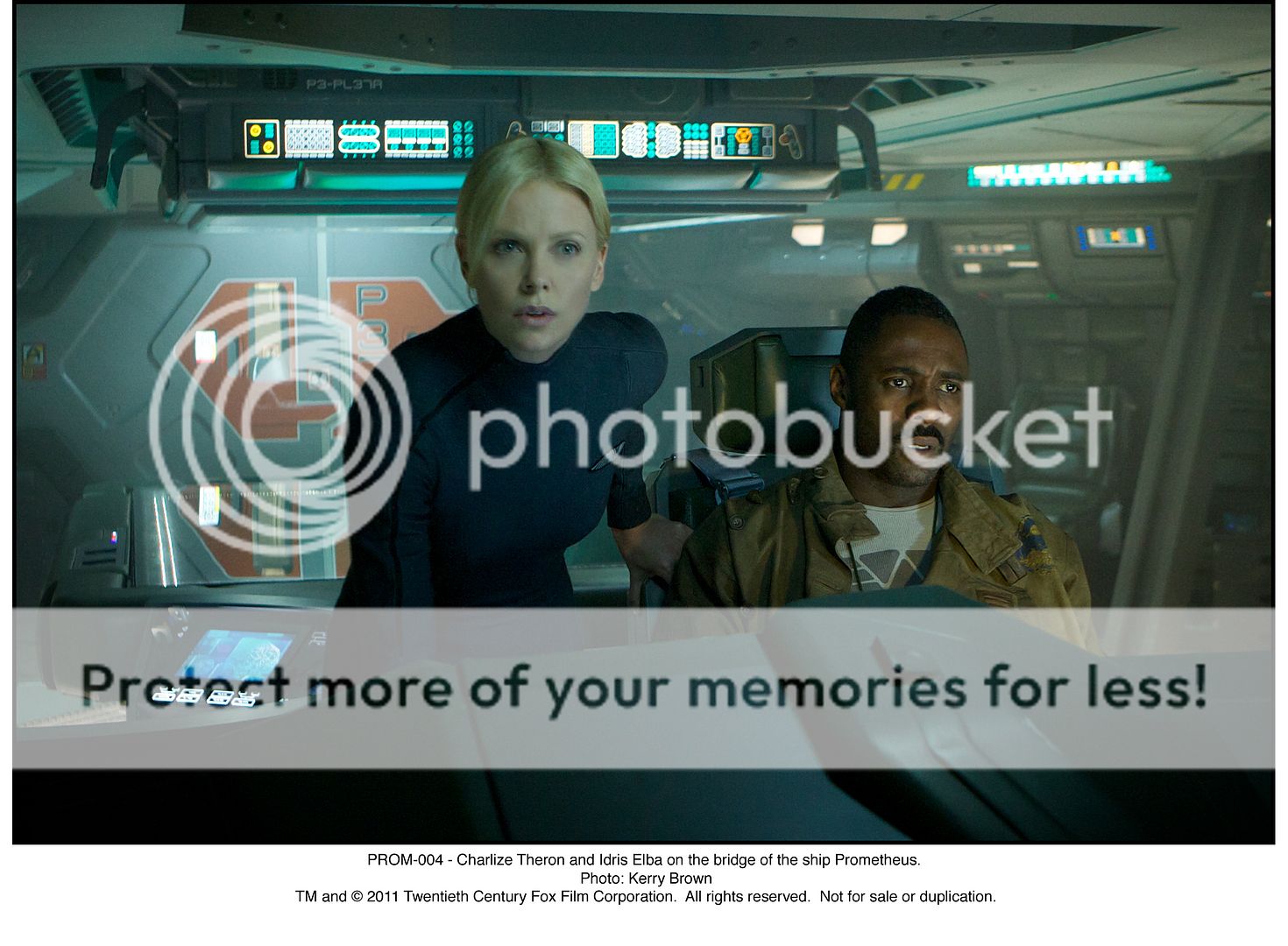
Scott’s commitment to the grand scope of
Prometheus rewards the audience with a technological and engineering masterpiece of science fiction, starting with the visually arresting sets and action sequences. So extraordinary are the special effects of the scientific exploration of the alien planet and consequent battles, one would falsely assume they are CGI. But Scott built enormous sets and shot the majority of the film live in three dimensions. One production crew member called it the “greatest alien playground in the world.” The state-of-the-art spacecraft, modeled after current NASA and European Space Agency designs, was constructed with every piece of technology that would be necessary to probe the outer corners of the galaxy. Techno-geeks will salivate over sleek gadgetry like the self-operating medical pod, research labs capable of immediately isolating and sequencing single strands of DNA, travelling “mind pop” mapping devices that can isolate life, not to mention sleep-state pods where the scientists are suspended for their two-year journey. Prometheus gives a credible peek into what our science and technology capabilities will be like a hundred years from now.
Ultimately, for all of its ambition and far-reaching scope, Prometheus eventually buckles under its own weight of self-importance. The existential questions it is asking are sci-fi staples. Who are we? Where do we come from? How do we reconcile science and religion in our quest to define our identities? And finally, embodied by the advanced-technology android David, what are the parameters of responsibility in the creation of life? And what is the reason for the frailty about when and why it begins and ends? Unfortunately, the film only dabbles enough with each to titillate without ever providing fulfilling answers. The audience may finish the Prometheus quest philosophically unsatisfied, but the journey there is still an action-packed, viscerally stunning sci-fi ride.
Prometheus goes into theaters nationwide on June 11, 2012.
View the trailer:
~*ScriptPhD*~
*****************
ScriptPhD.com covers science and technology in entertainment, media and advertising. Hire our consulting company for creative content development.
Subscribe to free email notifications of new posts on our home page.
]]>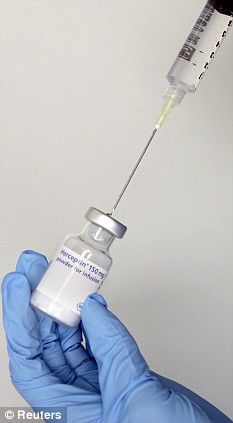
“It’s like a war. You don’t know whether you’re going to win the war. You don’t know if you’re going to survive the war. You don’t know if the project is going to survive the war.” The war? Cancer, still one of the leading causes of death despite 40 years passing since the National Cancer Act of 1971 catapulted Richard Nixon’s famous “War on Cancer.” The speaker of the above quote? A scientist at Genentech, a San Francisco-based biotechnology and pharmaceutical company, describing efforts to pursue a then-promising miracle treatment for breast cancer facing numerous obstacles, not the least of which was the patients’ rapid illness. If it sounds like a made-for-Hollywood story, it is. But I Want So Much To Live is no ordinary documentary. It was commissioned as an in-house documentary by Genentech, a rarity in the staid, secretive scientific corporate world. The production values and storytelling offer a tremendous template for Hollywood filmmakers, as science and biomedical content become even more pervasive in film. Finally, the inspirational story behind Herceptin, one of the most successful cancer treatments of all time, offers a testament and rare insight to the dedication and emotion that makes science work. Full story and review under the “continue reading” cut.
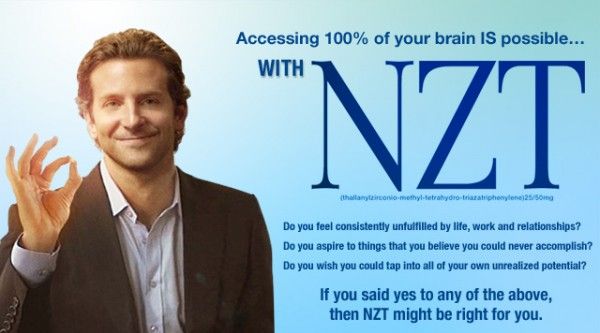
For biotechnology and pharmaceutical companies, it is the best of times, it is the worst of times. On the one hand, many people consider this a Golden Era of pharmaceutical discovery and innovation for certain illnesses like cancer. Others, such as HIV, receive poor grades for drug and vaccine development. Furthermore, the FDA recently passed much more stringent controls on drugs brought to market, leaving some to posit that this will have a negative impact on future pharmaceutical breakthroughs. And while a recent documentary chronicles some of the unhealthy profits of the pharmaceutical industry, the enormous cost of developing and bringing medicines to market is often gravely overlooked. Today, the pharmaceutical industry as a whole has one of the lowest favorability scores of any major industry, despite some impressive social contributions, partnerships and global health investments. Much of this public hostility simply comes down to the fact that people don’t know very much about the pharmaceutical industry, notoriously reluctant to publicize or reveal anything about their inner workings.

Science in Hollywood is experiencing no such crisis. In many ways, it is a golden age for science, technology and medicine in film, with more big-budget mainstream films exploring themes and content germane to 21st Century science than ever before. Last year alone, three smart hit movies broached the realities, hopes and anxiety of the technological times we live in, each in a very different way. The stylish and ambitious thriller Limitless explored the possibility of a limitless brain capacity through pharmacopeia, a magical pill that would maximize one’s intelligence and allow 100% brain function around the clock. Certainly echoing the credo of the modern pharmaceutical movement—there is a pill that can solve every problem, whether it’s been invented or not—Limitless fell slightly short in condemning (or even properly acknowledging) the impracticalities ethical irresponsibility of developing such a drug, especially in its ending. Stephen Soderbergh’s surgical and pinpoint-accurate epic Contagion gave audiences a spine-chilling, terrorizing purview into the medical and public health realities of a modern-day pandemic. But while it strove, and succeeded, in showcasing how government agencies, university labs and medical establishments would contend with and fight off such a global disaster, Contagion was never able to connect audiences emotionally either with the characters impacted by the pandemic or with the scientists battling it. No recent movie is a better example of delicate introspection and exposition than the brilliant, poignant, funny and difficult 50/50. On the heels of CNN pondering whether Hollywood could take on cancer came a film that did so with reality, grace and even humor. Partially because it was based on screenwriter Will Reiser’s own brush with cancer, 50/50 set aside the clinical as a secondary backdrop to examine the psychological.
Each of the films above has an important quality that is be an essential component to effective Hollywood science storytelling – scientific accuracy, emotional connection to the outside world and an overview of biomedical impact and innovation. We recently screened an industry documentary, filmed at the request of Genentech scientists, called I Want So Much To Live, that is an excellent blueprint for the way we’d like to see scientific stories portrayed in film. Best of all, it doesn’t sacrifice the human story for the technical one, nor the very real complex emotions that scientists, engineers and doctors feel when they develop and market potentially life-saving technology.
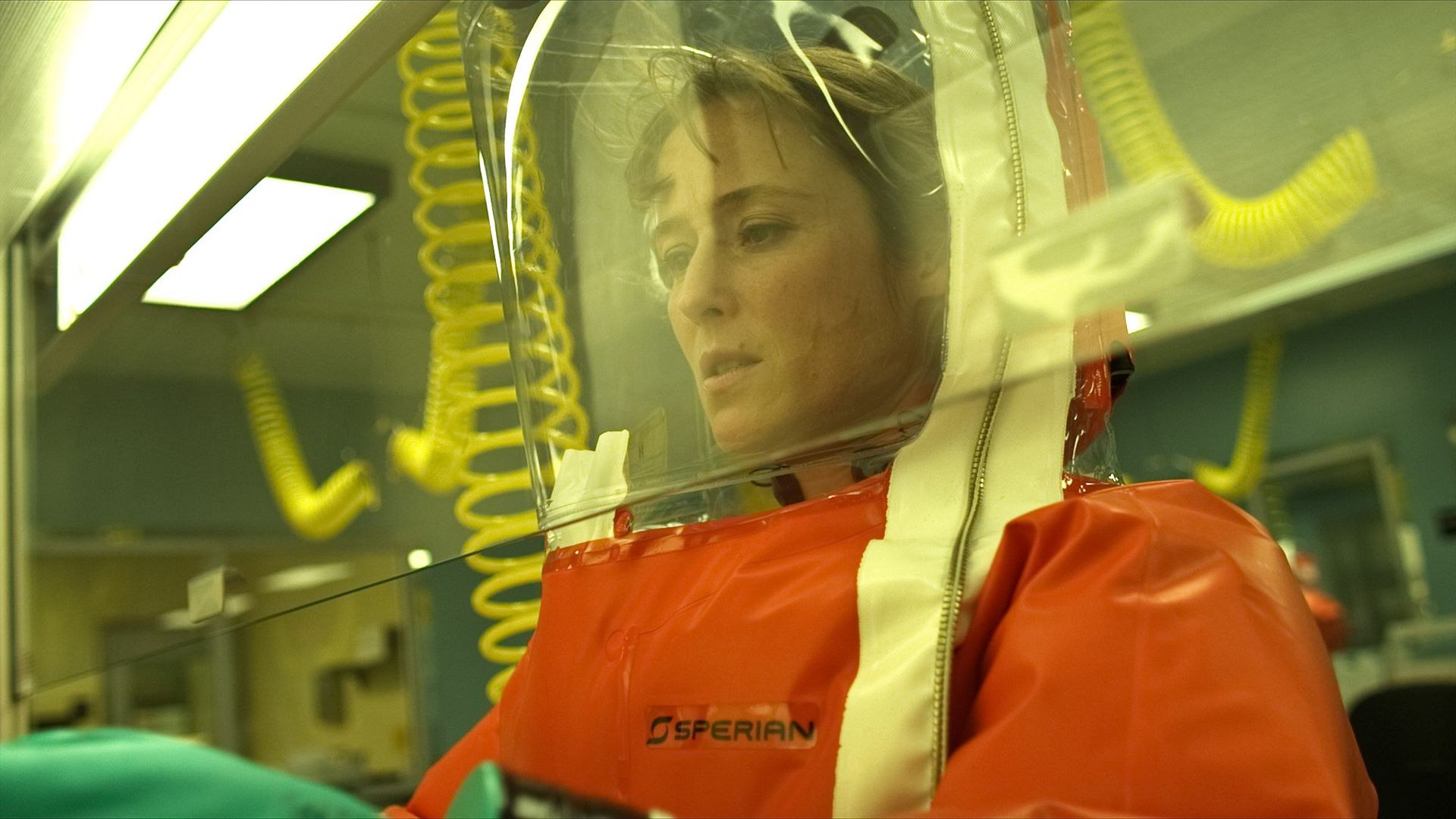
The miracle of Herceptin is really a decade-long journey that started in the labs of UCLA, moved to the pharmaceutical labs of San Francisco, endured countless obstacles, street riots and controversies to end up as one of the most revolutionary breakthroughs in breast cancer treatment research history. Advances in cancer insight always seem to come in evolutionary leaps. For example, the cellular mechanism of how normal cells become cancerous was unknown until Harold Varmus and Michael Bishop established the presence of retroviral oncogenes, genes that control cellular growth and replication. When either disrupted or turned on, these genes contribute to the transformation of normal cells into tumors. Other than the discovery of as an anti-estrogen treatment for breast cancers, relatively little new ground had been gained in fighting the disease. Scientists continued to be perplexed why some women were cured by chemotherapy, which tries to stop cancer cell division by attacking the most rapidly-dividing cells in the body, while others didn’t respond at all. It was not until the late 80s that scientists Alex Ullrich and Michael Shepherd (both featured in the film) discovered that about 20-30% of early-stage breast cancers express amplify a gene called HER-2, a protein embedded in the cell membrane that helps regulate cell growth and signaling. With the help of UCLA scientist Dennis Slamon, famously portrayed by Harry Connick, Jr. in a made-for-TV movie about the development of Herceptin, the scientists soon developed an anti-HER-2 antibody that significantly slowed tumor growth.
An early Phase I clinical trial was conducted simply to establish safety, with 20 volunteers. The lone survivor, still alive to this day, was given 10 weeks to live. Phase II trials honed in on dosage and establishing that the drug performed its intended effects. This time, out of 85 volunteers, 5 survived completely, not a bad result, but not enough for the FDA and the science community. The scientists took a huge risk for their Phase III study. They combined their anti-HER-2 antibody with current treatment. The results were astounding. Out of 450 patients, 50% survived — the highest ever success rate for metastatic cancer!
Think the story ends here? Think again. This is where it just begins to take more emotional twists and turns than a fictitious Hollywood script. Unlike many Hollywood productions, though, the human impact angle was shared equally between all the players in this evolving story, easily this documentary’s most powerful aspect. In order to test their Phase III trials of Herceptin (in concert with chemotherapy treatments available at that time), Genentech had to establish a highly controversial lottery system to pick those who would receive highly limited life-saving quantities of Herceptin, and those who would be categorized in the control studies, and thereby handed a death sentence. So controversial was the lottery system, that it engendered televised protests in the Bay Area, along with anguished pleas from dying patients—the documentary’s title is the first sentence of one such letter: “I want so much to live.” The scientists at Genentech were hardly immune to the weight of each decision, either. They were tormented over the fairness of the lottery system, producing enough high-quality treatment to pass the clinical trial, and even in keeping an unbiased eye on the science to save lives in the long run. Talking about the pressure of those days reduced one of the scientists to tears. And after all was said and done, the lone FDA scientist entrusted with the power to oversee the Herceptin study and green light its approval as a drug? She had just lost her mother to breast cancer. These intertwining fortunes are summarized by executive producer Christie Castro: “By definition, groups of people are imperfect. But those who worked on Herceptin proved that the complexity – indeed, the fantastic mess – that simply comes with being human can sometimes result in something truly worthwhile.”
One of the first patients to get the experimental Herceptin treatment prior to FDA approval, though not profiled in the movie, is flourishing well over a decade after being diagnosed with the most aggressive form of breast cancer. Stories like hers lie at the emotional heart of the I Want So Much To Live story (and Genentech’s motivation for continuing the controversial studies):
Herceptin was officially approved as a drug on September 22, 2000. On October 20, 2010, Herceptin was approved as an adjuvant (joint) treatment with current chemotheraphy drugs for the treatment of aggressive breast cancer. To date, the adjuvant therapy has had an impressive 58% success rate for a cancer that once carried an unlikely rate of survival for those afflicted.
Take a look at the trailer for I Want So Much To Live:
The powerful and well-crafted content of this documentary should serve as a valuable template for how the multi-faceted power of storytelling can be used across multiple industries. It smartly tells a gripping scientific story without either dumbing down the science or elevating it beyond a layperson’s understanding—a certain goal for the increasing amount of cinematic fare such as Contagion. It provides a functional breakdown of the enormous challenges and technical obstacles of the pharmaceutical drug development process. Like many other aspects of science, it is mysterious to the general public, out of their grasp and seemingly always occuring behind closed doors. Especially at a time when public perception of the pharmaceutical industry is at an all-time low, such transparency could strengthen reputations and increase business. “Corporations are,” executive producer Christine Castro reminds us, “groups of people who have ideas, ambitions, conflicts and dreams, and, at the end of the day, a desire to see their work result in something meaningful. That’s why we decided to take a creative chance and face the potential skepticism that a corporation would or could tell an unvarnished story about itself.”
Finally, the film develops a three-dimensional emotional tether to the three different sides impacted by the scientific process: scientists, the agencies that regulate them and society as a whole. There doesn’t always have to be a tacit bad guy, and sometimes, this protagonistic complexity makes for the best story of all. Holder, who started filming I Want So Much To Live around the same time that her late brother was diagnosed with a rare and virulent form of cancer, echoed our sentiment as she reflected on the process of making the film. It allowed her to discover “that science is a creative pursuit as well as a technical one; that science is beautiful and can be accessible; and that anyone, at any time, might have the idea that could one day save lives.”
We can only hope that the harmony of creativity, passion and emotion devoted to all sides of the drug discovery process within this film translates to more private and studio productions dealing with complex scientific and socio-technological issues.
ScriptPhD.com caught up with filmmaker Elizabeth Holder, who directed and produced I Want So Much To Live. Here are some of her thoughts on putting together this incredible story and interacting with the scientists and heroic patients that made it happen:
ScriptPhD.com: Can you tell me where the seeds of inspiration for the story of the drug Herceptin first arose, and what inspired you to tackle this material for your documentary?
Elizabeth Holder: The initial idea to make a documentary film about Herceptin came from executive producer Chris Castro, who upon joining Genentech in 2007 thought that the story would make a compelling documentary film. (She will have to share with you her experience.) I first heard about the project from a friend and began doing research on Herceptin and Genentech. I was excited to work on this film; excited to jump into and explore a new world. My first inspiration came from the people who were the story; the passionate men and women who faced adversity with courage and perseverance, never swaying from their pursuit, making difficult decisions laced with moral and ethical ramifications. I knew this story of individual and collective growth would resonate with many, and would be especially poignant to the employees of Genentech. (This at the time was the intended audience for the film.) When I began working on this film in 2008 I had no idea how personal this journey would become and how connected I would be to the people I would meet and the story I was going to tell.
While I was making the film, my younger brother David was battling cancer – a rare type of cancer for a 33 year old man. While I was meeting with scientists and learning about biotech and drug development for the movie, David was fighting the disease with everything science and medicine could offer. He wrote a blog about his journey, signing off each entry with the words “Plow On”. Each day, I would hope that the scientists would hurry up. Figure it out. But I learned firsthand that science is not a “hurry up” business and that many people are doing everything they can to find ways to stop cancer. My wish is that the film serves to inspire everyone who is on the frontlines in the battle against cancer, to encourage them to keep on fighting the good fight, no matter what, and even on a bad day, to Plow On.
SPhD: How willing were the patients and scientists to contribute to the project?
EH: As you can imagine, everyone, especially scientists, are skeptical. Some people took a bit more convincing than others, but once they started talking, the interviews, both on and off camera, were amazing.
I am grateful to the patients, scientists, activists, executives, and doctors for honestly and enthusiastically sharing their stories, perspective, and experience with me. I quickly became indebted to mentors and colleagues who diligently and without judgment explained and re-explained molecular biology and the drug development process to me. I hope the determination and delight in which they approach their work is reflected in the film.
SPhD: Any of your own preconceived notions that were shattered or altered throughout the making of this film?
EH: I discovered striking similarities between scientists and filmmakers which I did not expect to find. A research scientist and a filmmaker must each imagine an idea, convince others to recognize the value of funding the idea, and then prove the concept. Like many filmmakers, the scientists I met were impassioned about their work and showed great determination in the face of extraordinary odds. Like filmmaking, drug development takes a village. Before making this film I had no idea how many years and how many people it took to develop a drug; the process involves a huge collaborative effort between massive numbers of people in multiple organizations, in various countries.
It was incredible and amazing to me that the scientists would talk about “cells” and “exxons” and “nucleotides” as if they could actually be seen by the human eye. It was also inspiring to me that a scientist is committed enough to work on a research project for their whole career with the knowledge that they might not ever see an outcome in their lifetime. And finally, I was pleased to confirm (though not statistically proven) that a lot of really smart and accomplished people do not have perfectly clean desks.
SPhD: Within the movie, we get a real feel for the dichotomy between the emotional appeals of the desperately ill patients, the cautious, careful FDA scientists, and the Genentech researchers who want to make sure the product they introduce is safe for patients. Was this a thematic element you foresaw or that developed as you pieced the film together?
EH: I carefully planned out the film, yet also left room for new discoveries along the way. (I was constantly learning – from each filmed interview, from advisors, from books.) For each defining moment in the film I made sure to film at least three people talking about the same experience with different opinions. I wanted to make sure that the topic was covered from various perspectives so I could intercut interviews together. I knew that I was not going to use narration. I only wanted people who were part of the story to be telling the story; to engage the audience with their firsthand accounts. I wanted the audience to feel connected emotionally to each person in the film, to empathize with the person on screen even if they disagreed with their tactic and/or goal. Additionally, I knew I was going to use archival footage, photos and authentic documents to organically reveal the isolation and miscommunication, the unwitting partnerships, the building mistrust and the eventual coming together. When I first saw and read the pile of letters saved by Geoff, I knew that I would use it in the film. I carried a few of those letters with me to every interview and pulled them out when it felt right, asking people to read them and respond. The scene was assembled to show how incorrect assumptions lead to strife; to show how each person’s journey was critical to the whole story; and to show how those intertwining stories eventually became the framework for the work that is continuing today.
SPhD: What are your own thoughts on the lottery system that Genentech ultimately used to determine who would be eligible to participate in the Herceptin clinical trials?
EH: I see both sides of the issue, and don’t think there is an easy answer. When interviewing people for this film, I went into each interview with a clean slate, without having any pre-conceived agenda or opinion. It was critical that I empathized with each person and was able to tell the story though the objectives and needs of those who I interviewed, those who had direct experience. I needed to be able to fully see and feel the situation from their point of view. And, to me, judgment is only something that pulls us apart, not together. I am thankful I am in the documentary business and not in the business of making the kind of decisions that had to be made during that time. I am not sure what I would have done if someone I loved needed the drug before it was approved.
~*ScriptPhD*~
*****************
ScriptPhD.com covers science and technology in entertainment, media and advertising. Hire our consulting company for creative content development.
Subscribe to free email notifications of new posts on our home page.
]]>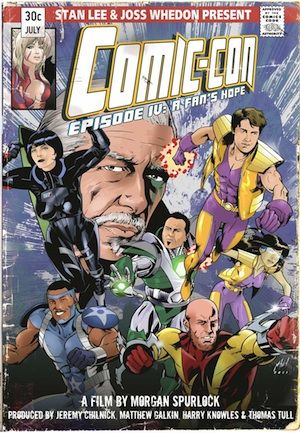
Every July, hundreds of thousands of fans descend upon the city of San Diego for a four-day celebration of comics, sci-fi, popular arts fandom and (growingly) previews of mainstream television and film blockbusters. What is this spectacular nexus of nerds? Comic-Con International, of course! From ScriptPhD’s comprehensive past coverage, one can easily glean the diversity of events, guests and panels, with enormous throngs patiently queueing to see their favorites. But who are these fans? Where do they come from? What kinds of passions drive their journeys to Comic-Con from all over the world? And what microcosms are categorized under the general umbrella of fandom? Award-winning filmmaker Morgan Spurlock attempts to answer these questions by crafting the sweet, intimate, honest documentary-as-ethnography Comic-Con Episode IV: A Fan’s Hope. Through the archetypes of five 2009 Comic-Con attendees, Spurlock guides us through the history of the Con, its growth (and the subsequent conflicts that this has engendered), and most importantly, the conclusion that underneath all of those Spider-Man and Klingon costumes, geeks really do come in all shapes, colors and sizes. For full ScriptPhD review, click “continue reading.”
In 1970, comics fan Shel Dorf organized a three-day gathering in San Diego at the US Grant hotel as a fringe gathering for the most enthusiastic amateur comics fans, aspiring artists and writers to interact with comics pros. It drew 300 fans. This was the backdrop against which young Morgan Spurlock grew up in West Virginia, passionately consuming comics and horror films, transported to a different world where everyone was a little bit askew and “weird.” “I wasn’t just a fan,” Spurlock remarks. “I was addicted.” It wasn’t until 2009 that he was able to make his first amateur journey to Comic-Con International San Diego, by now a cultural juggernaut regularly drawing over 150,000 fans, amid a vastly changed (and comics-cultural) landscape. Nevertheless, Spurlock was thrilled. He ran into boyhood idol Marvel animator Stan Lee, and thanked him for all the confidence and creativity he helped to inspire. Stan’s response? “Let’s make a documentary about Comic-Con!” And so, gathering forces with Lee, sci-fi cult icon Joss Whedon, among others, Spurlock embarked on a two-year journey that captured the 2010 Con (the 40th Anniversary edition) in all its glory—including panels, parades, photos, costumes and interviews with notable celebrities that have turned passions into professions. Most of all, however, Spurlock captured the fans.
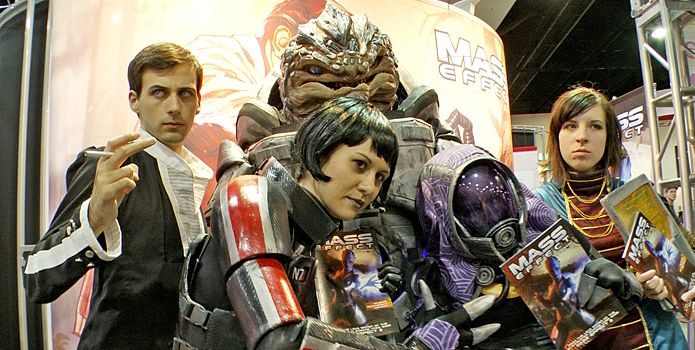
To winnow down the most compelling stories for the documentary, Spurlock held a casting call online that drew thousands of submissions. Among them was Holly Conrad, a talented, award-winning costume designer from a small town hoping to win the grand prize at the annual Comic-Con costume show. Knowing her slim odds, especially because of where she comes from, and the importance of making a splash for her career to take off, Holly called Comic-Con a “suicide mission for her future.” Also in a pressure cooker was Chuck Rozanski, proprietor of Mile High Comics, Americas largest inventory and dealer of comic books. Chuck uses the hectic, chaotic, crowded Comic-Con exhibit area to sell rare and collectible comics, comprising a substantial portion of his company’s income for the year, but faces a more fractured Con, with a smaller focus on comics every year. If he doesn’t make a killing at this year’s Com, Chuck knows the future of his whole business might be at risk. Sharing the convention floor with Chuck are comics-obsessed bartender Skip Harvey and US Airforce pilot and family man Eric Henson, two amateur graphic artists also putting their destiny on the line in San Diego. Armed with only a portfolio and a dream, Eric and Skip are hoping to get noticed at the portfolio critique sessions and land a professional design contract with one of the comics representatives. One succeeds (to the preview audience’s delight) and one learns he is a very big fish in a very small bowl, and must cultivate his talent for the greater stage. Intermingled for comic relief is the adorable story of James Darling and Se Young Kang, a couple who met and started dating at the previous year’s Con. James is planning to ask Se Young to marry him at this year’s Con, but must overcome a slew of hilarious obstacles to pull of his nerdy romantic feat.

Comic-Con Episode IV: A Fan’s Hope is a terrific purview into the conflicts and dissent of the modern Con. Hidden beneath the popularity of the yearly event is a schism between older fans who have been coming for years (and feel somewhat lost in the shuffle) and the new fans, such as lovebirds James and Se Young, who may not even necessarily be there for comics events. Longtime attendees such as Kevin Smith admitted that the event has become a “beancounter” with tremendous power to preview movies and television, something Hollywood has noticed and latched onto. One can legitimately forget the presence of comics and the graphic arts at Comic-Con altogether without trying very hard. This presents a huge problem for the poignant storyline of Chuck Rozanski, with whom we empathize as he struggles to sell comics through 4-day event. When ScriptPhD.com asked Spurlock at a recent Los Angeles junket about what surprised him the most, he pointed to the sheer volume of what goes on at Comic-Con, especially the job-hunting aspect of the Comic-Con exhibition floor. His favorite moment in the movie is the comparison of Comic-Con to a Russian nesting doll, with events hidden beneath other events. “I showed the movie to people and they responded that they didn’t even know that went on at Comic-Con! There is something for everyone, no matter what your passion.” Spurlock remarked.
The documentary is at its strongest and most successful when the focus turns to what the essence of what Comic-Con is defined by—the fans. “We all weighed in with what we thought were the most important pieces of the story,” Spurlock says. “But in the end it all came back to the fans.” It is the fans whose enthusiasm drives the growth of events like Comic-Con, however much nostalgia for the past may feel threatened. It is the fans whose passion continues to motivate and drive geniuses like Stan Lee to this very day. That very same passion also launches new careers, as Holly Conrad found. Since the filming of this documentary, she has moved to Hollywood and found successful work as a costume designer on several productions. Lastly, and most importantly, it is the fans who create that magical atmosphere where no matter who you are, where you come from, what you look like, how “out there” you behave, you find total acceptance and camaraderie amongst a group of treasured friends just as passionate and devoted as you are. To Spurlock, the Con “reminds us all of the importance of dreams and of wonder. It’s not just an event… it’s a state of mind.”
Trailer for Comic-Con Episode IV: A Fan’s Hope:
“Making of” featurette:
Comic-Con Episode IV: A Fan’s Hope was released in select cities on April 5, and theaters and video on demand on April 6th.
~*ScriptPhD*~
*****************
ScriptPhD.com covers science and technology in entertainment, media and advertising. Hire our consulting company for creative content development.
Subscribe to free email notifications of new posts on our home page.
]]>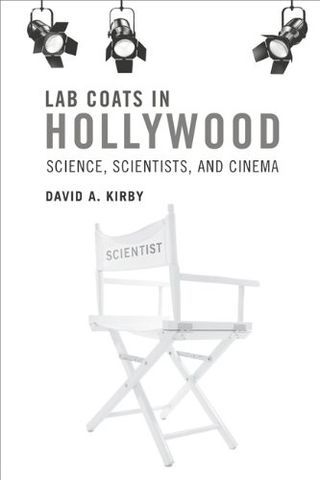
Read through any archive of science fiction movies, and you quickly realize that the merger of pop culture and science dates as far back as the dawn of cinema in the early 1920s. Even more surprising than the enduring prevalence of science in film is that the relationship between film directors, scribes and the science advisors that have influenced their works is equally as rich and timeless. Lab Coats in Hollywood: Science, Scientists, and Cinema (2011, MIT Press), one of the most in-depth books on the intersection of science and Hollywood to date, serves as the backdrop for recounting the history of science and technology in film, how it influenced real-world research and the scientists that contributed their ideas to improve the cinematic realism of science and scientists. For a full ScriptPhD.com review and in-depth extended discussion of science advising in the film industry, please click the “continue reading” cut.
Written by David A. Kirby, Lecturer in Science Communication Studies at the Centre for History of Science, Technology and Medicine at the University of Manchester, England, Lab Coats offers a surprising, detailed analysis of the symbiotic—if sometimes contentious—partnership between filmmakers and scientists. This includes the wide-ranging services science advisors can be asked to provide to members of a film’s production staff, how these ideas are subsequently incorporated into the film, and why the depiction of scientists in film carries such enormous real-world consequences. Thorough, detailed, and honest, Lab Coats in Hollywood is an exhaustive tome of the history of scientists’ impact on cinema and storytelling. It’s also an essential and realistic road map of the challenges that scientists, engineers and other technical advisors might face as they seriously pursue science advising to the film industry as a career.
The essential questions that Lab Coats in Hollywood addresses are these—is it worth it to hire a science advisor for a movie production? Is it worth it for the scientist to be an advisor? The book’s purposefully vague conclusion is that it depends solely on how the scientist can film’s storyline and visual effects. Kirby wisely writes with an objective tone here because the topic is open to a considerable amount of debate among the scientists and filmmakers profiled in the book. Sometimes a scientist is so key to a film’s development, he or she becomes an indispensible part of the day-to-day production. A good example of this is Jack Horner, paleontologist at the Museum of the Rockies in Bozeman, MT, and technical science advisor to Steven Spielberg in Jurassic Park and both of its sequels. Horner, who drew from his own research on the link between dinosaurs and birds for a more realistic depiction of the film’s contentious science, helped filmmakers construct visuals, write dialogue, character reactions, animal behaviors, and map out entire scenes. J. Marvin Herndon, a geophysicist at the Transdyne Corporation, approached the director of the disaster film The Core when he learned the plot was going to be based on his controversial hypothesis about a giant uranium ball in the center of the Earth. Herndon’s ideas were fully incorporated into the film’s plot, while Herndon rode the wave of publicity from the film to publish his research in a PNAS paper. The gold standard of science input, however, were Stanley Kubrik’s multiple science and engineering advisors for 2001: A Space Odyssey, discussed in much further detail below.

Kirby hypothesizes that sometimes, a film’s poor reception might have been avoided with a science advisor. He provides the example of the Arnold Schwarzenegger futuristic sci-fi bomb The Sixth Day, which contained a ludicrously implausible use of human cloning in its main plot. While the film may have been destined for failure, Kirby posits that it only could have benefited from proper script vetting by a scientist. By contrast, the 1998 action adventure thriller Armageddon came under heavy expert criticism for its basic assertion that an asteroid “the size of Texas” could go undetected until eighteen days before impact. Director Michael Bay patently refused to take the advice of his advisor, NASA researcher Ivan Bakey, and admitted he was sacrificing science for plot, but Armageddon went on to be a huge box office hit regardless. Quite often, the presence of a science advisor is helpful, albeit unnecessary. One of the book’s more amusing anecdotes is about Dustin Hoffman’s hyper-obsessive shadowing of a scientist for the making of the pandemic thriller Outbreak (great guide to the movie’s science can be found here). Hoffman was preparing to play a virologist and wanted to infuse realism in all of his character’s reactions. Hoffman kept asking the scientist to document reactions in mundane situations that we all encounter—a traffic jam, for example—only to come to the shocking conclusion that the scientist was a real person just like everyone else.
Most of the time, including scientists in the filmmaking process is at the discretion of the studios because of the one immutable decree reiterated throughout the book: the story is king. When a writer, producer or director hires a science consultant, their expertise is utilized solely to facilitate, improve or augment story elements for the purposes of entertaining the audience. Because of this, one of the most difficult adjustments a science consultant may face is a secondary status on-set even though they may be a superstar in their own field. Some of the other less glamorous aspects of film consulting include heavy negotiations with unionized writers for script or storyline changes, long working hours, a delicate balance between side consulting work and a day job, and most importantly, an inconsistent (sometimes nonexistent) payment structure per project. I was notably thrilled to see Kirby mention the pros and cons of programs such as the National Science Foundation’s Creative Science Studio (a collaboration with USC’s school of the Cinematic Arts) and the National Academy of Science’s Science and Entertainment Exchange, which both provide on-demand scientific expertise to the Hollywood filmmaking community in the hope of increasing and promoting the realism of scientific portrayal in film. While valuable commodities to science communication, both programs have had the unfortunate effect of acclimating Hollywood studios to expect high-level scientific consulting for free.
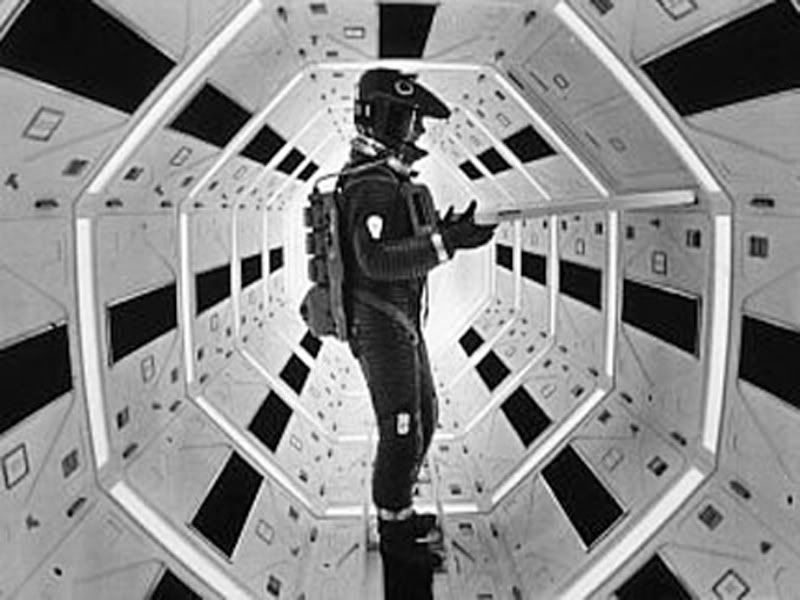
1968’s 2001: A Space Odyssey is widely considered by popular consensus to be the greatest sci-fi movie ever made, and certainly the most influential. As such, Kirby devotes an entire chapter to detailing the film’s production and integration of science. Director Stanley Kubrik took painstaking detail in scientific accuracy to explore complex ideas about the relationship between humanity and technology, hiring a range of advisors from anthropologists, aeronautical engineers, statisticians, and nuclear physicists for various stages of production. Statistician I. J. Good provided advice on supercomputers, aerospace Harry Lange provided production design, while NASA space scientist Frederick Ordway lent over three years of his time to develop the space technology used in the film. In doing so, Kubrik’s staff consulted with over sixty-five different private companies, government agencies, university groups and research institutions. So real was the space technology in 2001 that moon landing hoax supporters have claimed the real moon landing by United States astronauts, taking place in 1969, was taped on the same sets. Not every science-based film has used science input as meticulously or thoroughly since, but Kubrik’s influence on the film industry’s fascination with science and technology has been an undeniable legacy.
One of the real treats of Lab Coats in Hollywood is the exploration of the two-way relationship between scientists and filmmakers, and how film in turn influences the course of science, as we discuss in more detail below. Between film case studies, critiques and interviews with past science advisors are interstitial vignettes of ways scientists have shaped films we know and love. Even the animated feature Finding Nemo had an oceanography advisor to get the marine biology correct. The seminal moment of the most recent Star Trek installation was due to a piece of off-handed scientific advice from an astronomer. The cloning science of Jurassic Park, so thoroughly researched and pieced together by director Steven Spielberg and science advisor Jack Horner, was actually published in a top-notch journal days ahead of the movie’s premiere. Even in rare spots where the book drags a bit with highly technical analysis are cinematic backstories with details that readers will salivate over. (For example, there’s a very good reason all the kelp went missing from Finding Nemo between its cinematic and DVD releases.)
As the director of a creative scientific consulting company based in Los Angeles, one of the biggest questions I get asked on a regular basis is “What does a science advisor do, exactly?” Lab Coats in Hollywood does an excellent job of recounting stories and case studies of high-profile scientist consultants, all of whom contributed their creative talents to their respective films in different ways, what might be expected (and not expected) of scientists on set, and of giving different areas of expertise that are currently in demand in Hollywood. Kirby breaks down cinematic fact checking, the most frequent task scientists are hired to perform, into three areas within textbook science (known, proven facts that cannot be disputed, such as gravity): public science, something we all know and would think was ridiculous if filmmakers got wrong, expert science, facts that are known to specialists and scientific experts outside of the lay audience, and (most problematic) folk science, incorrect science that has nevertheless been accepted as true by the public. Filmmakers are most likely to alter or modify facts that they perceive as expert science to minimize repercussions at the box office.
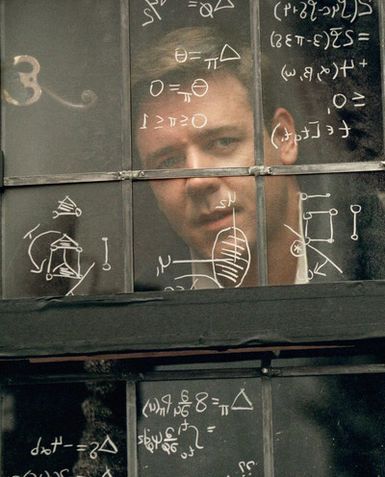
A science advisor is constantly navigating cinematic storytelling constraints and a filmmaker’s desire to utilize only the most visually appealing and interesting aspects of science (regardless of whether the context is always academically appropriate). Another broad area of high demand is in helping actors look and act like a real scientist on screen. Scientists have been hired to do everything from doctoring dialogue to add realism into an actor’s portrayal (the movie Contact and Jodie Foster’s depiction of Dr. Ellie Arroway is a good example of this), training actors in using equipment and pronouncing foreign-sounding jargon, replicating laboratory notebooks or chalkboard scribbles with the symbols and shorthand of science (such as in the mathematics film A Beautiful Mind), and to recreate the physical space of an authentic laboratory. Finally, the scientist’s expertise of the known is used to help construct plausible scenarios and storylines for the speculative, an area that requires the greatest degree of flexibility and compromise from the science advisor. Uncertainty, unexplored research and “what if” scenarios, the bane of every scientist’s existence, happen to be Hollywood’s favorite scenarios, because they allow the greatest creative freedom in storytelling and speculative conceptualization without being negated by a proven scientific impossibility. An entire chapter—the book’s finest—is devoted to two case studies, Deep Impact and The Hulk, where real science concepts (near-Earth asteroid impacts and genetic engineering, respectively) were researched and integrated into the stories that unfolded in the films. (Side note: if you are ever planning on being a science advisor read this section of the book very carefully).
In years past, consulting in films didn’t necessarily bring acclaim to scientists within their own research communities; indeed, Lab Coats recounts many instances where scientists were viewed as betraying science or undermining its seriousness with Hollywood frivolity, including many popular media figures such as Carl Sagan and Paul Ehrlich. Recently, however, consultants have come to be viewed as publicity investments both by studios that hire high-profile researchers for recognition value of their film’s science content and by institutes that benefit from branding and exposure. Science films from the last 10-15 years such as GATTACA, Outbreak, Armageddon, Contact, The Day After Tomorrow and a panoply of space-related flicks have attached big-name scientists as consultants (gene therapy pioneer French Anderson, epidemiologist David Morens, NASA director Ivan Bekey, SETI institute astronomers Seth Shostak and Jill Tartar and climatologist Michael Molitor, respectively). They also happened to revolve around the research salient to our modern era: genetic bioengineering, global infectious diseases, near-earth objects, global warming and (as always) exploring deep space. As such, a mutually beneficial marketing relationship has emerged between science advisors and studios that transcends the film itself resulting in funding and visibility to individual scientists, their research, and even institutes and research centers. The National Severe Storms Laboratory (NSSL) promoted themselves in two recent films, Twister and Dante’s Peak, using the films as a vehicle to promote their scientific work, to brand themselves as heroes underfunded by the government, and to temper public expectations about storm predictions. No institute has had a deeper relationship with Hollywood than NASA, extending back to the Star Trek television series, with intricate involvement and prominent logo display in the films Apollo 13, Armageddon, Mission to Mars, and Space Cowboys. Some critics have argued that this relationship played an integral role in helping NASA maintain a positive public profile after the devastating 1986 Challenger space shuttle disaster. The end result of the aforementioned promotion via cinematic integration can only benefit scientific innovation and public support.

Accurate and favorable portrayal of science content in modern cinema has an even bigger beneficiary than specific research institutes, and that is society itself. Fictional technology portrayed in film – termed a “diegetic prototype” – has often inspired or led directly to real-world application and development. Kirby offers the most impactful case of diegetic prototyping as the 1981 film Threshold, which portrayed the first successful implantation of a permanent artificial heart, a medical marvel that became reality only a year later. Robert Jarvik, inventor of the Jarvik-7 artificial heart used in the transplant, was also a key medical advisor for Threshold, and felt that his participation in the film could both facilitate technological realism and by doing so, help ease public fears about what was then considered a freak surgery, even engendering a ban in Great Britain. Of the many obstacles that expensive, ambitious, large-scale research faces, Kirby argues that skepticism or lack of enthusiasm from the public can be the most difficult to overcome, precisely because it feeds directly into essential political support that makes funding possible. A later example of film as an avenue for promotion of futuristic technology is Minority Report, set in the year 2054, and featuring realistic gestural interfacing technology and visual analytics software used to predict crime before it actually happens. Less than a decade later, technology and gadgets featured in the film have come to fruition in the form of multi-touch interfaces like the iPad and retina scanners, with others in development including insect robots (mimics of the film’s spider robots), facial recognition advertising billboards, crime prediction software and electronic paper. A much more recent example not featured in the book is the 2011 film Limitless, featuring a writer that is able to stimulate and access 100% of his brain at will by taking a nootropic drug. While the fictitious drug portrayed in the film is not yet a neurochemical reality, brain enhancement is a rising field of biomedical research, and may one day indeed yield a brain-boosting pill.
No other scientific feat has been a bigger beneficiary of diegetic prototyping than space travel, starting with 1929’s prophetic masterpiece Frau im Mond [Woman in the Moon], sponsored by the German Rocket Society and advised masterfully by Hermann Oberth, a pioneering German rocket research scientist. The first film to ever present the basics of rocket travel in cinema, and credited with the now-standard countdown to zero before launch in real life, Frau im Mond also featured a prototype of the liquid-fuel rocket and inspired a generation of physicists to contribute to the eventual realization of space travel. Destination Moon, a 1950 American sci-fi film about a privately financed trip to the Moon, was the first film produced in the United States to deal realistically with the prospect of space travel by utilizing the technical and screenplay input of notable science fiction author Robert A. Heinlein. Released seven years before the start of the USSR Sputnik program, Destination Moon set off a wave of iconic space films and television shows such as When Worlds Collide, Red Planet Mars, Conquest of Space and Star Trek in the midst of the 1950s and 1960s Cold War “space race” between the United States and Russia. What theoretical scientific feat will propel the next diegetic prototype? A mission to Mars? Space colonization? Anti-aging research? Advanced stem cell research? Time will only tell.
Ultimately, readers will enjoy Lab Coats in Hollywood for its engaging writing style, detailed exploration of the history of science in film and most of all, valuable advice from fellow scientists who transitioned from the lab to consulting on a movie set. Whether you are a sci-fi film buff or a research scientist aspiring to be a Hollywood consultant, you will find some aspect of this book fascinating. Especially given the rapid proliferation of science and technology content in movies (even those outside of the traditional sci-fi genre), and the input from the scientific community that it will surely necessitate, knowing the benefits and pitfalls of this increasingly in-demand career choice is as important as its significance in ensuring accurate portrayal of scientists to the general public.
~*ScriptPhD*~
***************
ScriptPhD.com covers science and technology in entertainment, media and advertising. Hire our consulting company for creative content development.
Subscribe to free email notifications of new posts on our home page.
]]>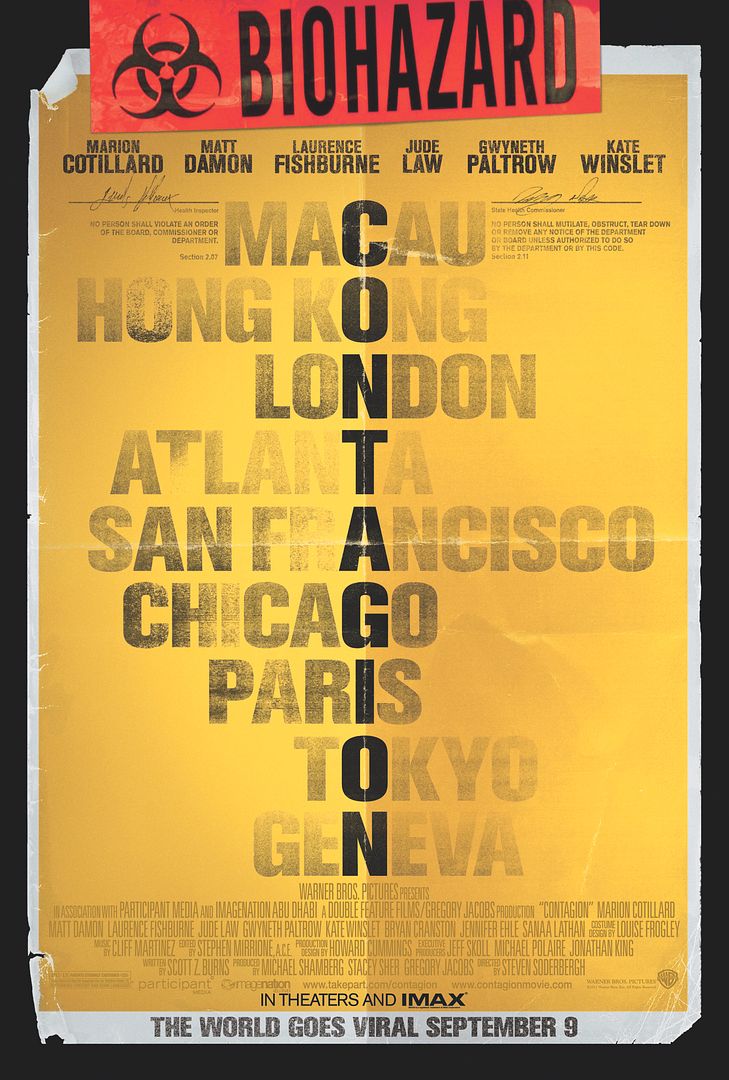
“Don’t talk to anyone, don’t touch anyone.” The austere slogan of the new film Contagion mirrors the gripping subject matter of the latest addition to the pandemic disaster movie club. One of the most science-oriented films to be released in the last few years, Contagion follows the path of several scientists, public health workers, and ordinary citizens as a full-fledged pandemic breaks out from an unknown virus. It explores scientific, moral, social and ethical questions for how we would prepare as a modern society if such a tragedy ever struck us. Additionally, Contagion is a cinematic ode to the visual and technical wonders of modern science, on full display here, both in the storyline and the beatifully-designed sets and costumes. For a full ScriptPhD review, including information on the behind-the-scenes science consultants that worked with the film’s producers to create scientific realism, click “continue reading” below.
REVIEW: Contagion
ScriptPhD Grade: B-
Contagion is one of those all-star Hollywood packages that seem too good to be true, and in this case it is. It’s clear that Oscar-winning director Steven Soderbergh (Erin Brokovich, Traffic, Ocean’s Eleven) paid attention to his advisors and took the time to get the science right, but perhaps he did so at the cost of any real drama making its way through the movie. The star-studded cast, which includes Matt Damon, Kate Winslet, Marion Cotillard, Gwyneth Paltrow, Jude Law and Lawrence Fishburne, may have delivered great performances in their original storylines, but the final cut is such an odd mash up of actionless sequences that it’s impossible to stay invested in any of their stories.

When Beth Ernhoff (Gwyneth Paltrow) returns home to Minneapolis, her bad case of let lag takes a perilous turn for the worse, and two days later, she is dead. To the shock and dismay of her grieving husband Thomas (Matt Damon), doctors don’t know the cause. Soon, the contagion spreads around our increasingly interconnected world, and a pandemic ensues. Scientists at the United States Centers for Disease Control soon take on deciphering the code of a rapidly mutating virus along with quelling the simultaneously rising tide of public panic. While Deputy Director Ellis Cheever (Laurence Fishbourne) allays public panic, Dr. Erin Mears (Kate Winslet) is sent directly into harm’s way. Concurrently, WHO Dr. Leona Orantes (Marion Cotillard) delegates solving the maze of clues that will eventually lead back to what ordinated the virus. While the doctors race time to find a cure, their efforts are thwarted by extremist activist blogger Alan Krumwiede (Jude Law), whose conspiracy theories that the public isn’t getting the whole story from the US Government, which sets of a wave of paranoia more dangerous than the virus itself.
Scientists rejoice! As a realistic depiction of a bird flu epidemic, Contagion attempts to right some of the scientific wrongs of Outbreak, which played more like a conventional zombie movie than a warning parable about the global reach of modern infectious diseases. Contagion was a difficult review for ScriptPhD to compose, because we’ve always marveled at the overt inaccuracies of its predecessor: an unauthorized person walking out of a secured government lab with a sample of a deadly virus (without gloves no less!), scientists and civilians walking into a Biosafety Level 4 lab without proper personal protective equipment, an unrealistic rate of viral spread, and we could go on and on…
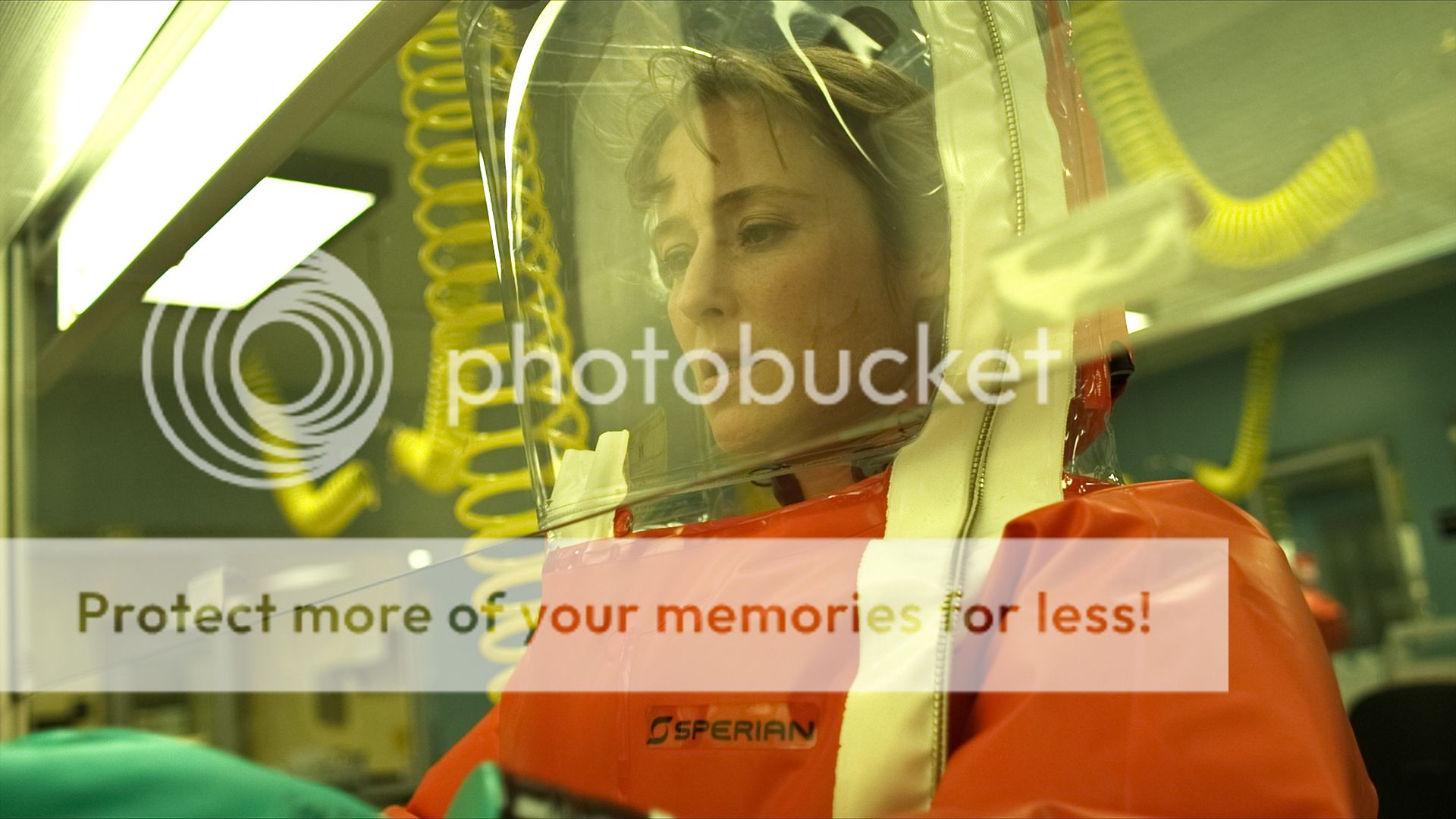
Thanks to the involvement of Participant Media and Warner Brothers, Contagion is a science film masquerading as a public service announcement to raise awareness about the possibility of such an outbreak and show that widespread panic is more dangerous than the virus itself. We applaud this goal. But too many minutes were invested in forcing actors to deliver technical language, along with clunky lines explaining their meaning. The balance between scientific accuracy and storytelling always has to ultimately tip in the balance of storytelling—the lynchpin of compelling films across all genres.
Showing scientists in realistic settings is noble and important, but lab work doesn’t qualify as action, and unfortunately for the viewing audience, that’s as good as it gets for this ‘action-thriller.’ As an example, Marion Cotillard’s Dr. Orantes is introduced in a tense moment of the film with a minute-long montage where we watch her take meetings—she’s literally sitting across a desk and talking to people—but we don’t get to hear what she’s saying because the awkward and uneven score plays over it. This is about the most boring visual montage I’ve ever seen in a movie. Then she gets thrown in a van and we don’t see her for another hour.
There’s a dark secret at the heart of how the virus afflicts Beth Ernhoff, but that drama isn’t allowed to play out in any meaningful way because there are five other plotlines to keep track of. Matt Damon gives some great scenes dealing with her death. But too many emotional punches were pulled: he skips over the death of his son to focus on somewhat-comically keeping his daughter locked away from the boy next door.

Fishburne and Winslet go a good job introducing the audience to the Center for Disease Control and the ridiculous pressures applied to government officials in their position, but don’t look for any happy endings in a movie this insistent on accurate depiction. Finally, Soderbergh is attempting to outdo himself in terms of the number of plotlines he can weave into a cohesive story, following up on his best director Oscar nod for Traffic. Where Traffic succeeded in integrating pieces into a cohesive whole, Contagion stretched my emotional attention span too thin. As the non-linear plot skips among all these amazing actors, the audience is constantly having to recall who they are and what they want.
This became comical at the wrong moment when the film returned to Cotillard’s character teaching schoolchildren in some Chinese village where she’s been held hostage. We are supposed to feel bad for these villagers, now that Marion has become one of them. But the theater was filled with a wave of frenzied whispers as entertainment bloggers consulted their neighbors on what she was doing there in the first place.
Speaking of writers and bloggers, Jude Law’s self-promoting freelancer Alan Krumwiede drew plenty of inside chuckles from the press screening crowd as a blogger seeking to profit from conspiracy theories about the government’s ties to pharmaceutical companies. His character is clearly a tongue-in-cheek homage to biological warfare NGO Sunshine Project muckraker and blogger Edward Hammond. This feeds into the film’s public service message to encourage us to trust our government in a big disaster situation, but it runs counter to the logic of movies that the little guy is corrupt and The Man is actually watching out for us.
If you’re interested in the subject matter or are fascinated by portrayal of science in film, Contagion is well worth the ticket price, but otherwise you’ll probably see it on Netflix in about three months. Contagion is hands-down the most realistic epidemic movie we’ve ever seen, but the film’s competing interests kept it from succeeding in any of its other lofty ambitions. Ultimately, it just wasn’t contagious enough.
Official Trailer:
Contagion goes into wide release on September 9, 2011 in theaters nationwide.
Natasha K. Griffith, MS, director of biosafety and biocontainment at the University of California at Los Angeles, and a world-renowned expert in training scientists to handle the most dangerous pathogens, consulted on all of the laboratory set design and high-tech suits that the actors wore during the filming. We had the opportunity to ask her a few questions about her work with Contagion.
ScriptPhD.com: Tell us a little bit about your expertise and specialty.
Natasha Griffith, MS: My expertise is in high containment laboratory design and management, primarily for Biosafety Level 3 and Biosafety Level 4 labs.
SPhD: Excellent. What kind of work, specifically, did you do for the film production crew? What were you asked to contribute?
NG: I was hired as a technical biosafety consultant. I helped with set design, that is making sure that the set was designed according to regulations, and to make sure that it matched actual BSL-3 and BSL-4 labs. Both are presented in the movie. I worked with the actors that were wearing containment suits at Level 4, and made sure that they knew what they were doing and felt comfortable in the suits. It can be a little difficult if you’ve never worn one of the suits before to just stick you into one and expect you to know what to do. I also oversaw the script, and made sure that all written lines were technically correct, and worked with the set designer to design the Level 3 and Level 4 suits. We also worked closely with the props department to make sure that the items used in the laboratory scenes and that the actors were working with were accurate research-wise. Before the filming even took place, I worked with the set and production designers to make sure that the labs were set up correctly and in place, including all the appropriate biosafety signs, and items in the freezers, and so on.
SPhD: Can you explain to people who are going to see the movie what the difference is between a Level 4 and a Level 3 lab?
NG: A Level 4 lab is truly what we call a “suit lab,” which is where the majority of this movie is presented. People are working in fully enclosed suits, so there’s no contact with the laboratory environment at all. All the air is provided through an external air line into the suit, so that people are not breathing in any air from the lab that might be contaminated with the agent they’re working with. It’s the highest possible level of containment that houses new agents, agents that have a very high mortality, and those that we don’t know much about or have a cure for. A Level 3 lab is one step down from Level 4, so there are different types of personal protective equipment that are used. In this case, the suits are not actually completely isolated from the laboratory environment, but the suits do filter the laboratory air through a special HEPA filter and eliminate any contaminants the scientist might have been exposed to. The agensts housed in a Level 3 lab are usually airborne [infectious disease agents], but we usually have some type of cure or treatment for them.
SPhD: Were there any moments during the filming of Contagion where you saw something terribly inaccurate being filmed and had to correct it? Can you give us examples?
NG: There were some details like this, but for the most part, the people I worked with were trying their best to be very accurate. Changing things wasn’t usually a big problem. A bigger challenge was explaining the highly technical information in such a way that the crew and actors could all understand what was going on and why certain things were important or something had to look a certain way. Usually, once we agreed on those big picture things, changing other small lab-specific details wasn’t a big problem.
SPhD: There have been a host of “pandemic” films that have come out in the last 10-15 years, dealing with global-scale pandemics, something really scary happening. And the fact is, we live in a global world, where in one day, you can travel across half the world (as is depicted in Contagion). The amount of stuff we touch in a given day is truly scary, which is another point the film touches on. In your opinion, having worked in this field, and all the things you’ve seen, is this storyline a Hollywood fantasy or something we should genuinely be investing our research money in and preparing for?
NG: Well, there’s always the possibility of a pandemic, and as you mentioned before, you truly can travel from one end of the world to the other in a very short period of time. So, anything that is new and emerging in Africa or Asia could be here tomorrow, so the risk definitely exists. Research money is obviously being invested already into preparedness, which is really the best way to prepare for such an event. I would say it’s definitely not a Hollywood fantasy. It is something that could happen, and something that we should keep in mind, but not something that we should be paranoid about. We have a lot of things that are always happening, and most of them don’t result in a huge pandemic. But you could say that one day, it might happen. One thing that really impressed me about Contagion was that they really, really tried hard to stay true to the science and what would happen if a pandemic actually happened.
The filmmakers of Contagion also consulted with Dr. Ian Lipkin, one of the world’s foremost microbe hunters and a professor at Columbia University’s Mailman School of Public Health. In addition to suggesting the movie’s plot might be triggered by an outbreak of a virus similar to Nipah, a deadly virus that has, on occasion, migrated from animals to people, Dr. Lipkin provided recollection of his work with the SARS epidemic in Beijing for the WHO and coached Contagion actors on the practices and procedures of scientific research. Here is a video of Dr. Lipkin discussing his work on the film, and why its broader message is so important for raising pandemic awareness and inspiring the next generation of science researchers:
~*Stephen Compson*~
************************
ScriptPhD.com covers science and technology in entertainment, media and advertising. Hire our consulting company for creative content development.
Subscribe to free email notifications of new posts on our home page.
]]>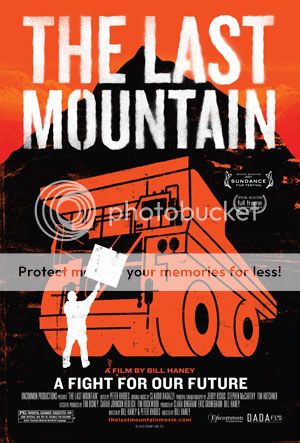
About a year ago, a little publicized, unheralded documentary named Mountaintop Removal (which ScriptPhD.com reviewed) attempted to deconstruct the environmentally devastating practice of the same name literally destroying the Appalachian geography of West Virginia’s coal river valley. Honest, yet modestly shot and produced, the small-scale documentary needed a Hollywood touch to resonate on a human level to advance its powerful cause. It got what it needed in The Last Mountain, a celebrated selection of this year’s Sundance Film Festival. This important new documentary succeeds in both relaying the urgency of a destructive coal mining practice that is literally zoning in on one last undamaged mountain as well as forging a human connection with the townspeople battling to save it. Full ScriptPhD.com review under the “continue reading” cut.
Most people don’t think twice about where the electricity for their light bulbs comes from. Or if they know it primarily comes from coal, they are not aware of how that coal comes to see the light of day. In the valleys and mountaintops of idyllic Appalachia, the coal industry detonates the explosive power of a Hiroshima bomb every week, utilizing a crude process called mountaintop removal. There is nothing scientific or technical about mountaintop removal. It is crude, cruel and its effects non-reversible. First, trees and other natural ecology are removed from the tops of mountains. Then, dynamite splits the mountain open to unearth a layer of coal that is mined by brave men risking their lives in ungodly working conditions. When the layer is depleted, the next layer is blasted, until nothing is left but a hollow shell of a devastated mountain. In its wake, the process leaves behind toxic sludge piles containing arsenic, lead and mercury, contaminated rivers and streams, fine particulate airborne matter that creates an epidemiological health nightmare, and unlivable communities. Mountaintop removal has already destroyed 500 Appalachian mountains, decimated 1 million acres of forests, and buried 2,000 miles of streams.
Take a look at a clip from The Last Mountain that shows the destruction from an aerial view:
In the beautiful mountains of the Coal River Valley in West Virginia, mining corporations such as Massey Energy are blasting the mountains of Appalachia into extinction, polluting the air and water with blithe impunity, and amassing the kind of profits that allow them to wield massive lobbying power in Washington, DC to both repeal existing environmental regulations and obviate the ratification of new ones. One small community has had enough. Their only schoolhouse sits at the base of a silo where 28 million gallons of toxic sludge left over from the coal mining are held back by a flimsy levee. Their neighbors and friends—ranging from 5 to 63 years old to—are dying in masses from strange tumor clusters. Water filters that should last 3-4 months get plugged up after two weeks. The very last mountain in Coal River, protecting the community from massive flooding after rainfall, is being targeted for blasting. And that is when the people of Coal River decide to fight back.
The Last Mountain is not just a standard environmental cautionary tale, but also an uplifting tale of citizens taking back their community. Helping the cause is noted environmentalist Robert F. Kennedy, Jr., who travels to Coal River, aligns with the community, and attends dozens of rallies that are held to protest the actions of Massey Energy. In one of the film’s lighter moments, a humble West Virginian remarks “I never thought I’d have a Kennedy in my living room!” It is these very human moments that ultimately connect the audience to a cause seemingly unrelated to our lives. The most poignant moment of The Last Mountain is live footage of Coal River residents that had traveled to the governor’s offices in Charlotte to present him with money raised through a local Pennies For Promise campaign to build a new, safer schoolhouse (an ultimately successful initiative.) At first the governor is touched, even amused, by the rural denizens. But when they bring up the actions of Massey Energy, and the governor’s own futility in stopping the damage to their community, he is stunned, even embarrassed, even going so far as to have the West Virginia government arrest the protesters—one of whom was a 91-year-old woman in a flag-draped wheelchair. “Why are our kids any different?” former Massey Energy contractor turned activist Ed Wiley shouts at the governor. “Because they’re in the coal fields? They’re on the wrong side of the mountain?”
If you think this movie, or mountaintop removal itself, doesn’t affect you, you’re wrong. Almost half of the electricity produced in the US comes from the burning of coal (that’s 16 pounds of coal each day for each man, woman, and child!). 32% of that coal comes from…you guessed it…the mountains of Appalachia. It also happens to be the #1 sources of greenhouse gases worldwide. And it doesn’t stop there. The toll on health from the burning of coal nationwide—contributing to such problems as 10 million asthma attacks, brain damage in newborns and thousands of premature deaths—adds up to $345 billion annually. We are all paying the cost of mountaintop removal in one way or another. You’re connected to coal, whether you realize it or not.
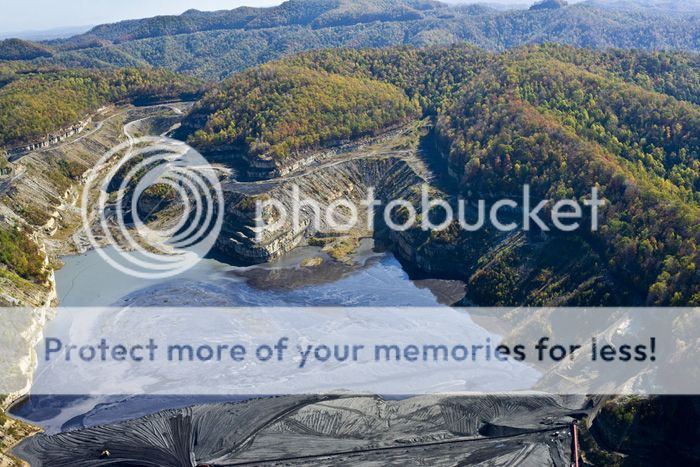
As The Last Mountain eventually conveys, this is a tale about so much more than blasting off a mountain—it’s about hubris and powerful people thinking they can do whatever they want, while destroying lives in the process. How’s this for a silent statistic? Massey Energy’s 28 impoundments have spilled 24 times in the last decade, contaminating rivers with 300 million gallons of sludge—that is twice the amount released in the BP oil spill in the Gulf that shocked the world. After a $28 million dollar settlement for their environmental violations, Massey Energy committed 180 more violations with no impunity. And the tragic thing is that the alternative technology is so much more effective and inexpensive. The filmmakers end with an uplifting visit to Portsmouth, WV, a municipality that supplies ¾ of its electricity needs for the community with two windmills with low-grade Category 2 winds. The winds in the Coal River Valley? The highest possible—Category 5. One can only imagine how many jobs and clean energy could be created from wind turbines in the Coal River Valley. A 1991 Department of Energy study concluded that only three US States, Kansas, North Dakota and Texas, have enough harnessable wind energy to supply the entire nations energy needs. Twenty years later, we have the technology to make it happen.
The ultimate message of The Last Mountain is that is not enough to simply be outraged anymore. We are all users of the electricity and power that is generated from the sacrifices of the Appalachia residents and miners. The imagery of environmental devastation is so shocking, the deregulation and egregious indifference of the coal mining companies’ various violations so appalling, that we begin to feel somehow complicit in perpetrating this modern American tragedy. Fixing it starts with watching documentaries like The Last Mountain, but also in taking the kind of inspiring action as that of the small rural West Virginia community that the film portrays. Ordinary people, banded together in a common purpose, can indeed move mountains. And sometimes, they can even save them.
Trailer:
The Last Mountain was released in limited screenings on June 15th, and goes into theaters nationwide later in June.
~*ScriptPhD*~
*****************
ScriptPhD.com covers science and technology in entertainment, media and advertising. Hire our consulting company for creative content development.
Subscribe to free email notifications of new posts on our home page.
]]>
